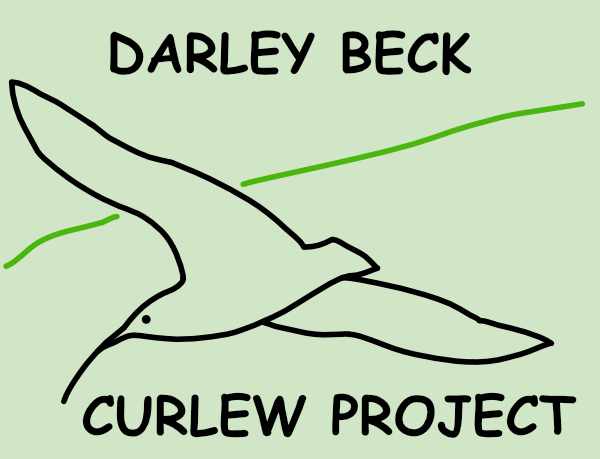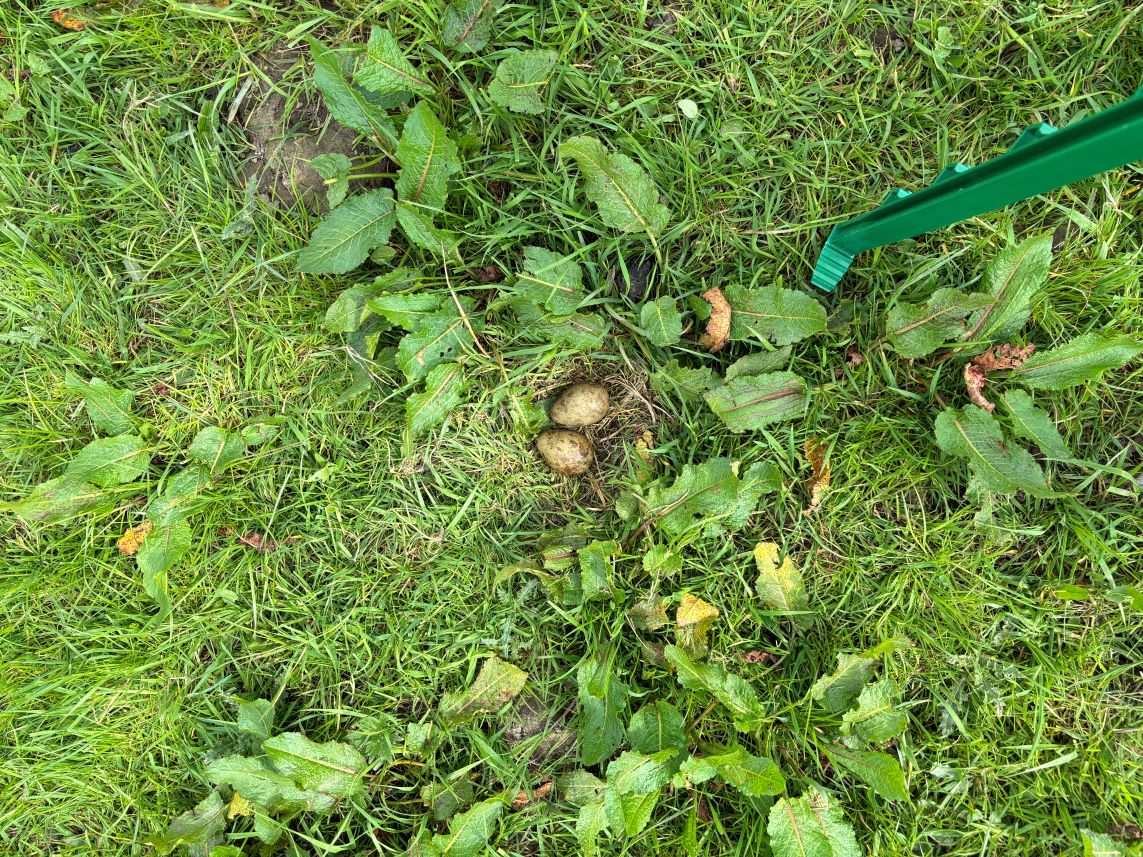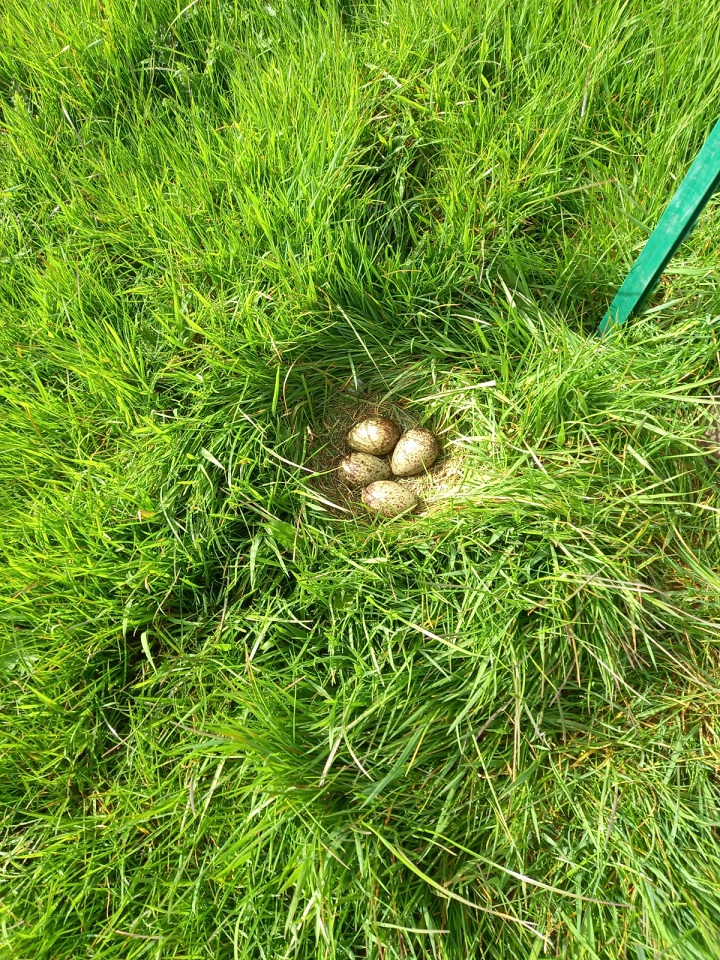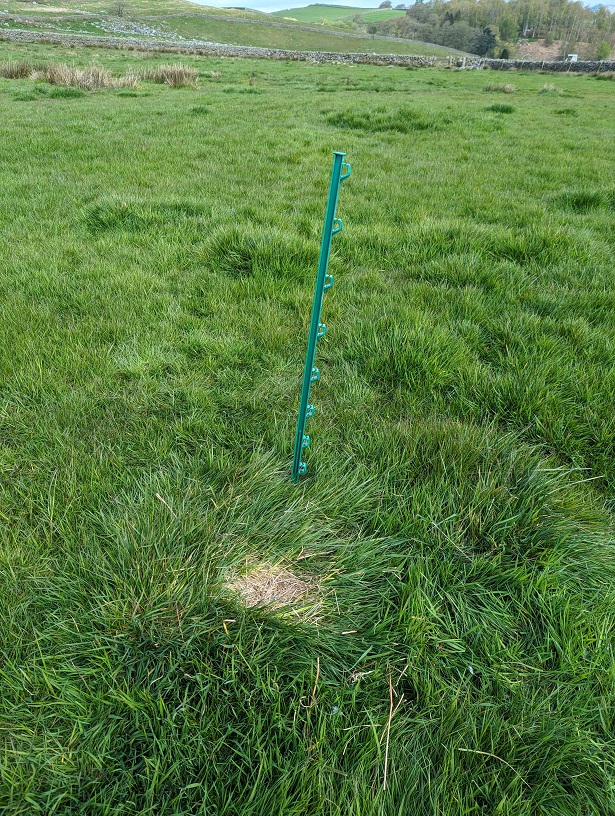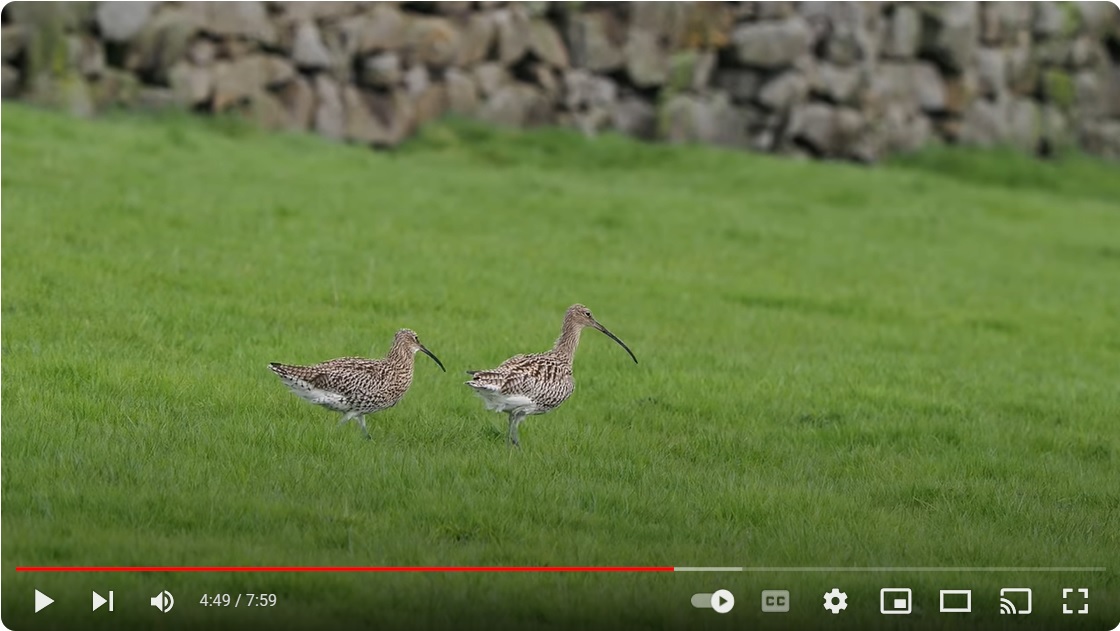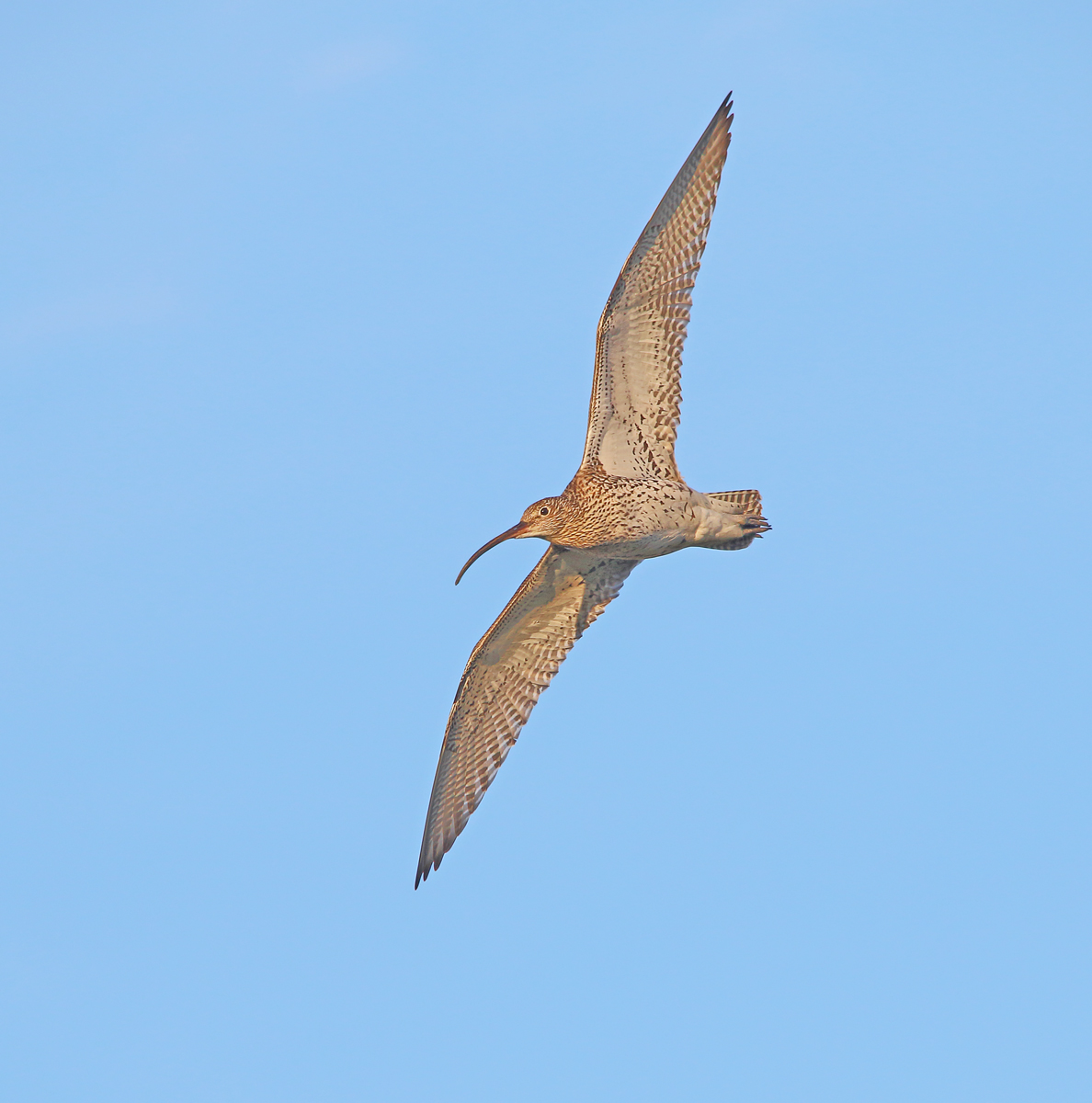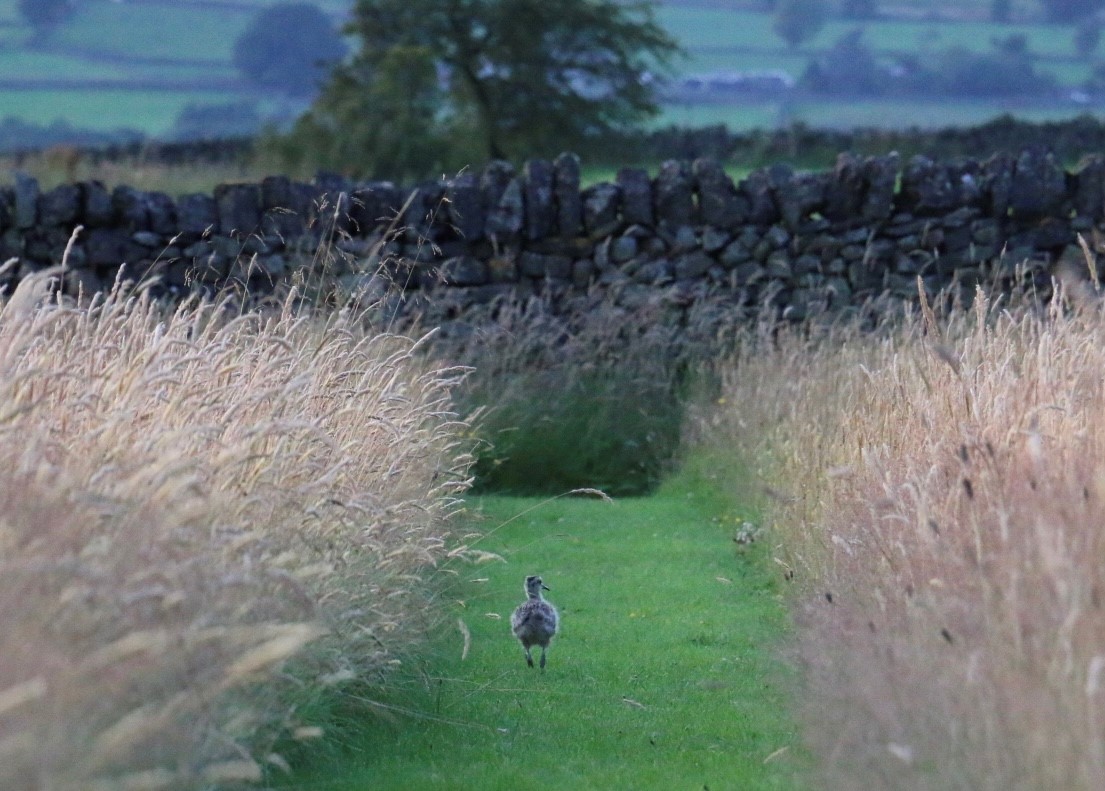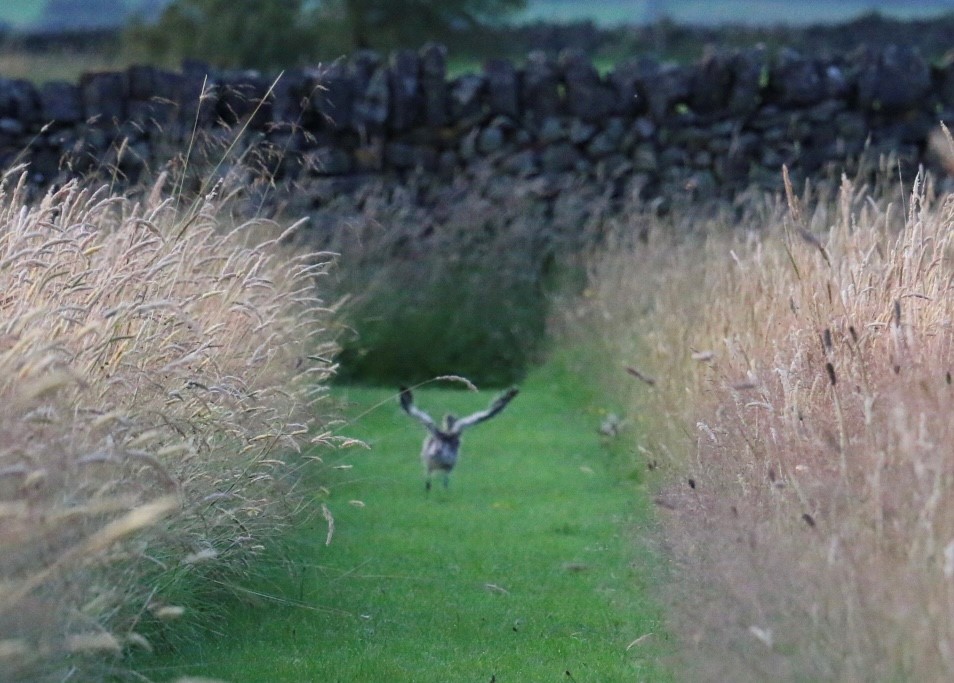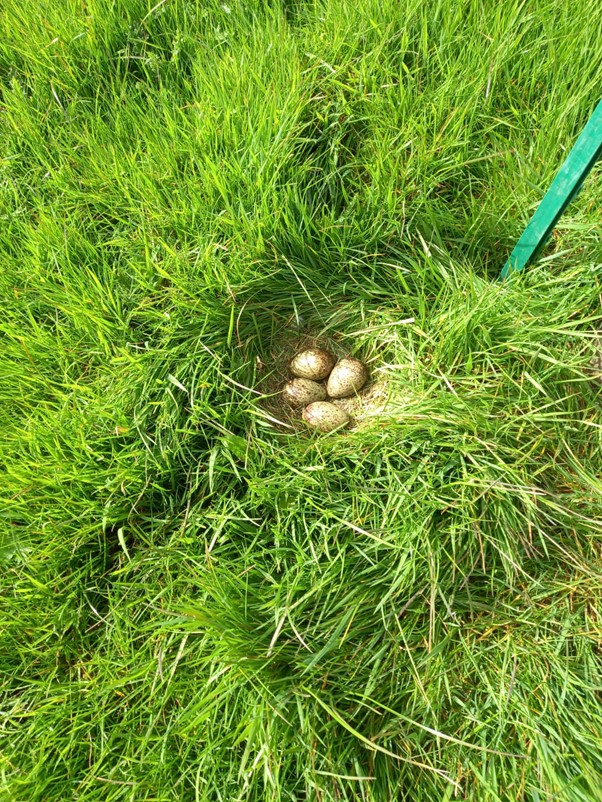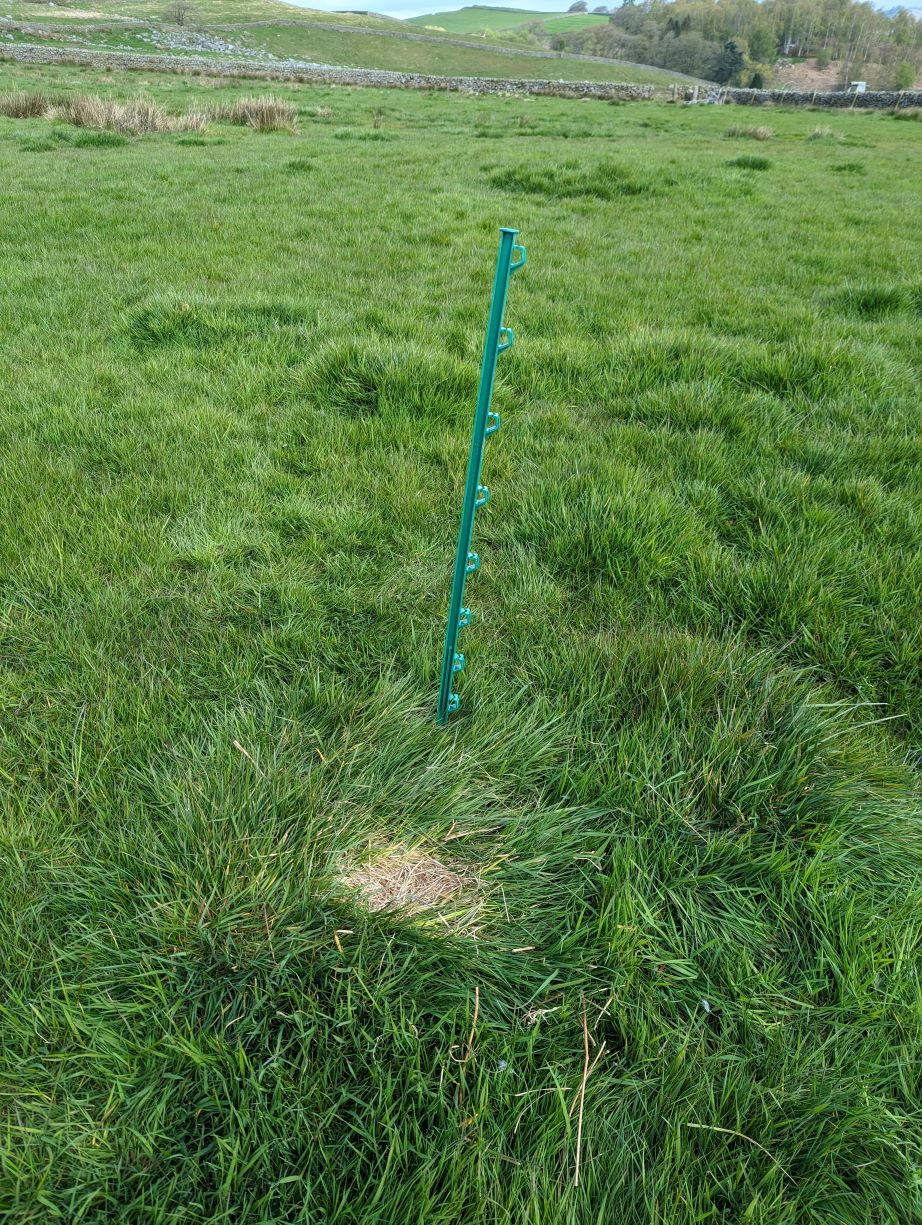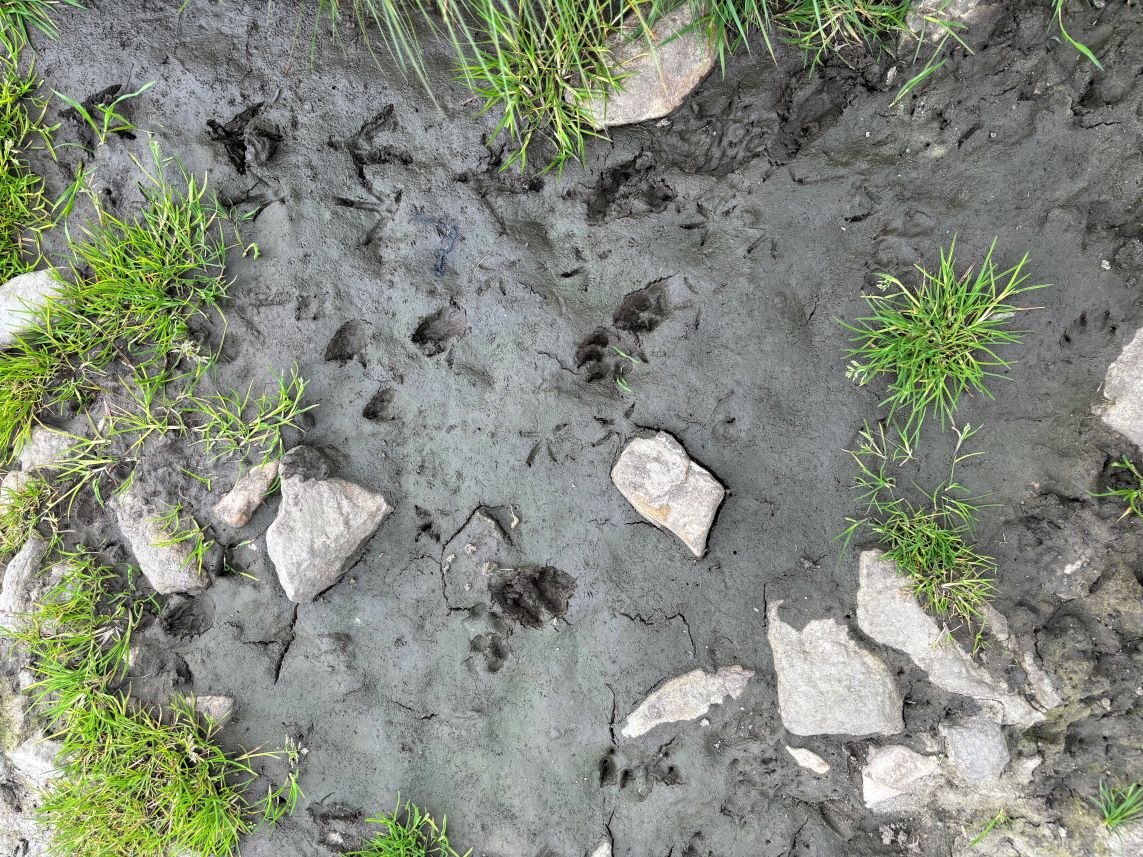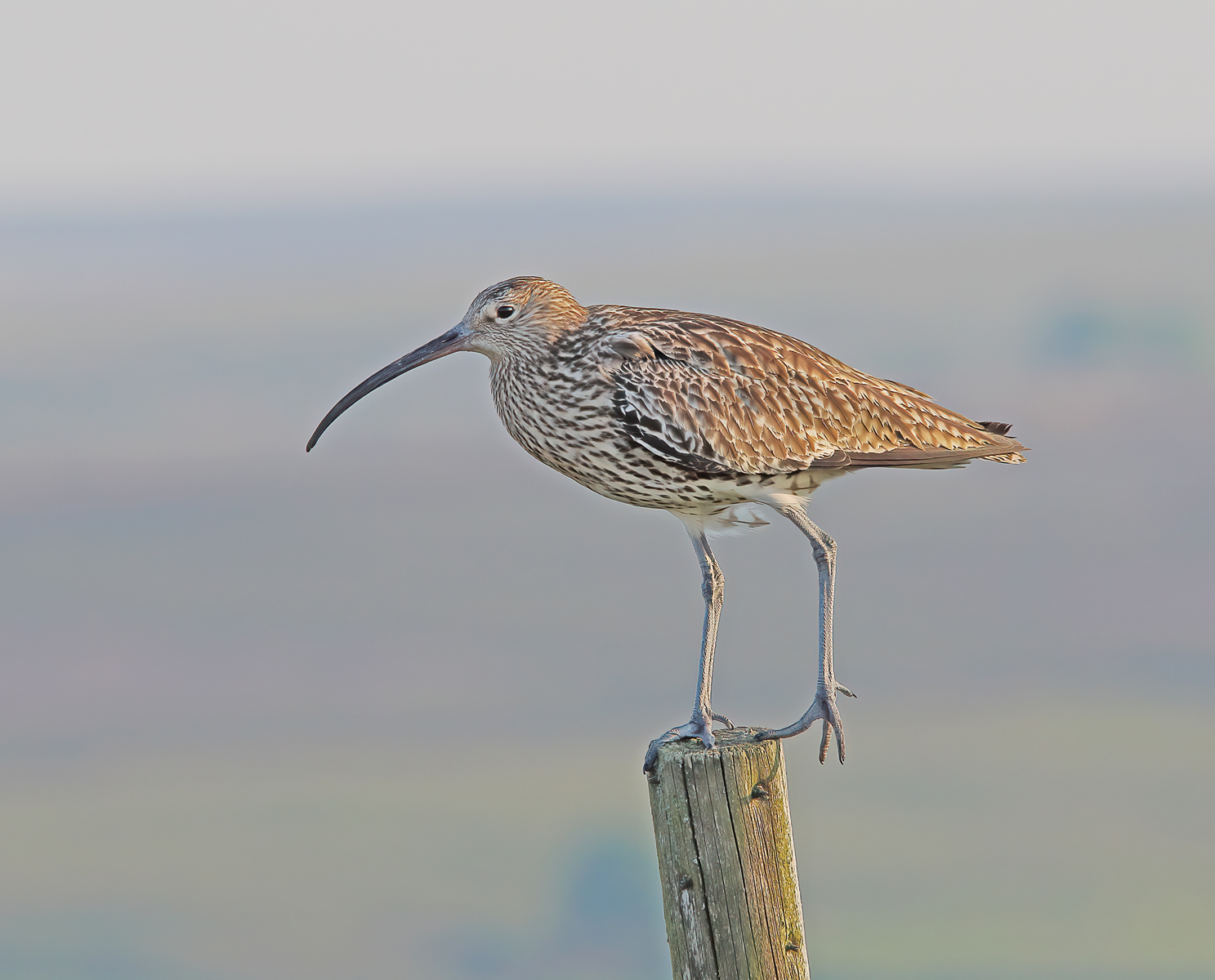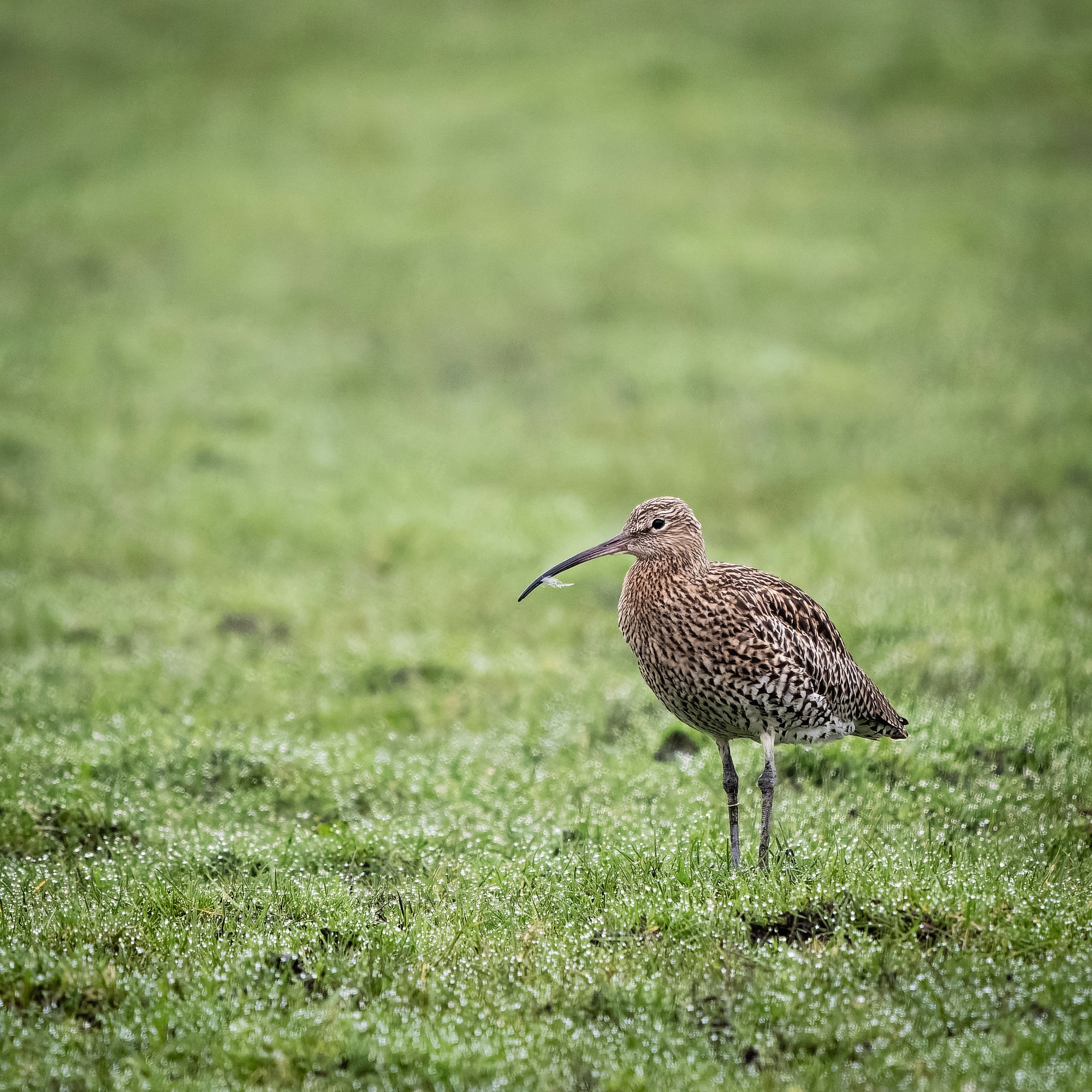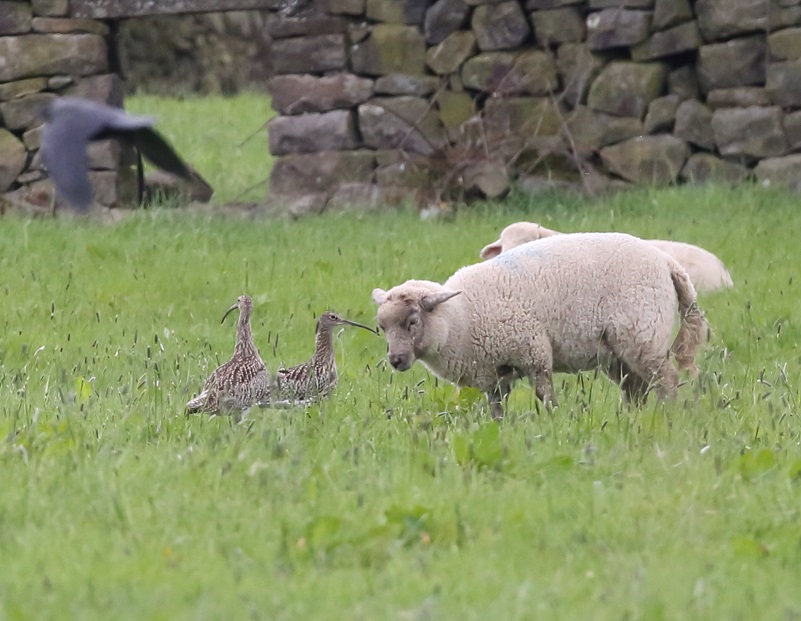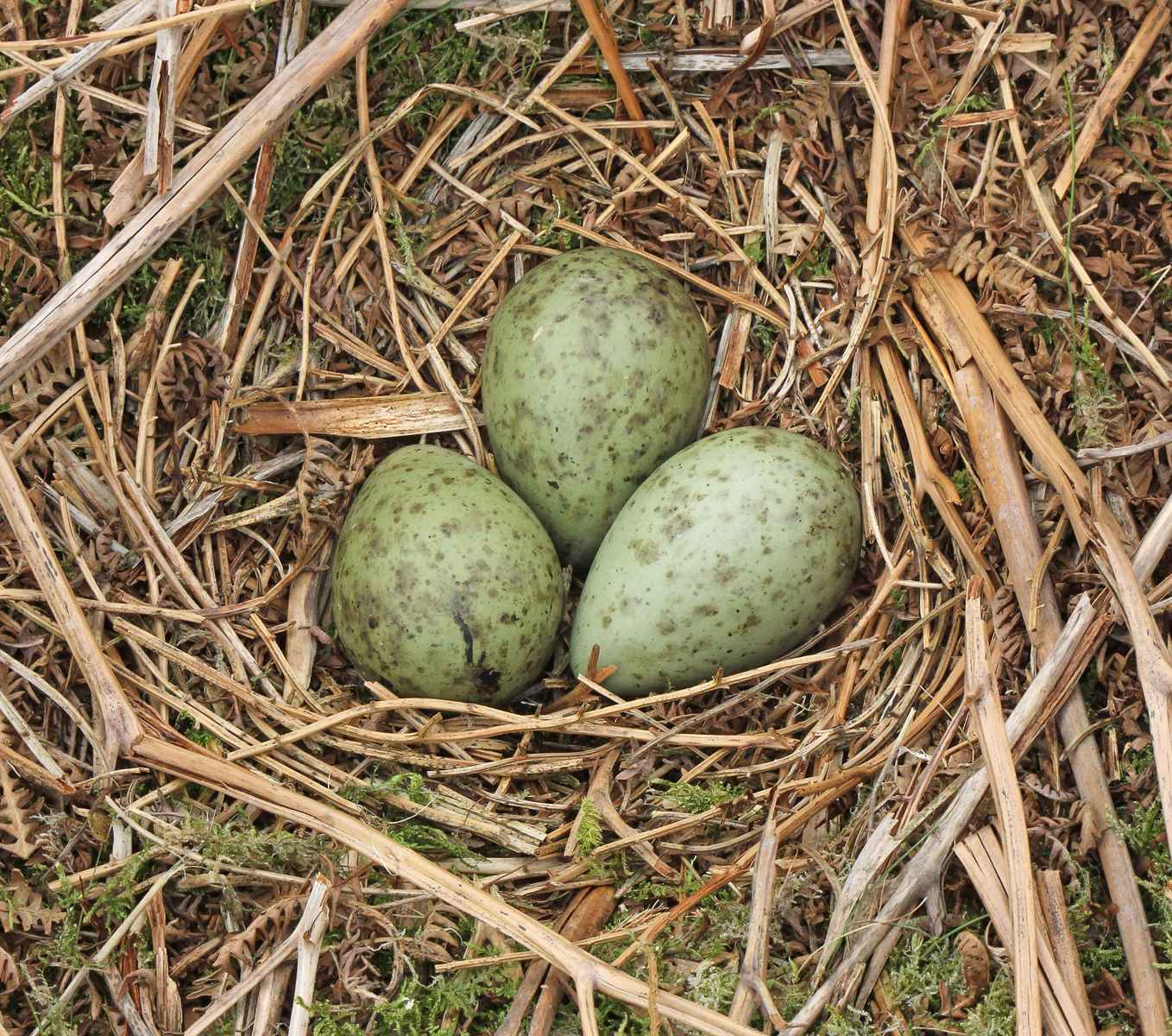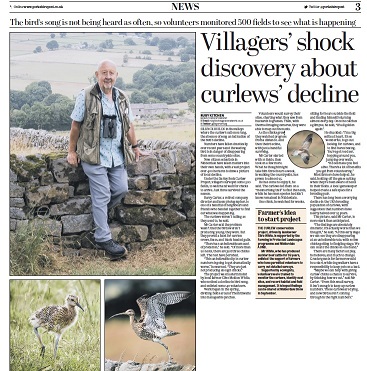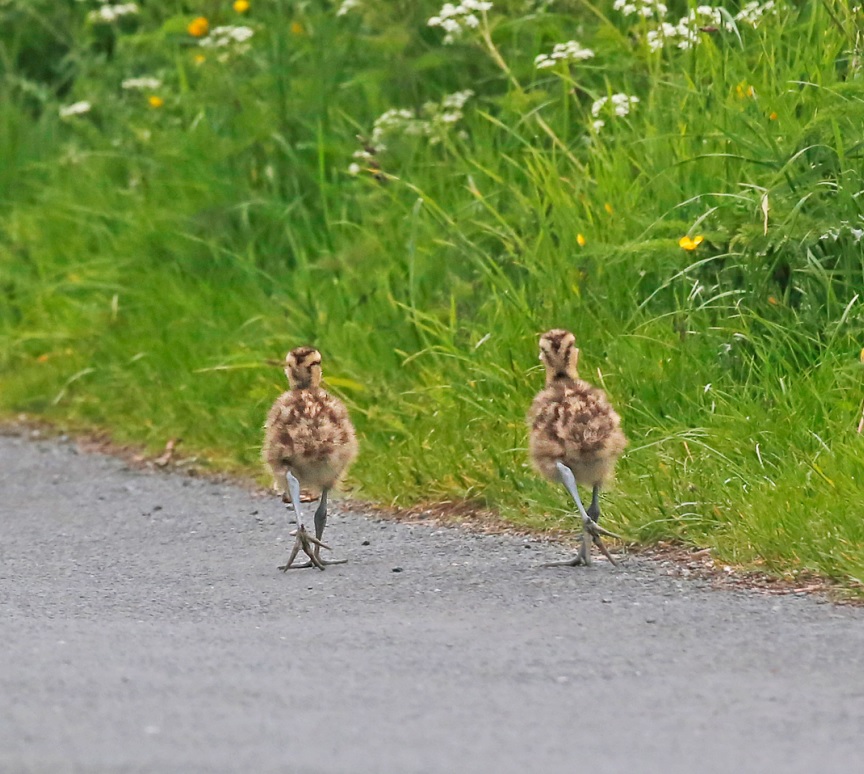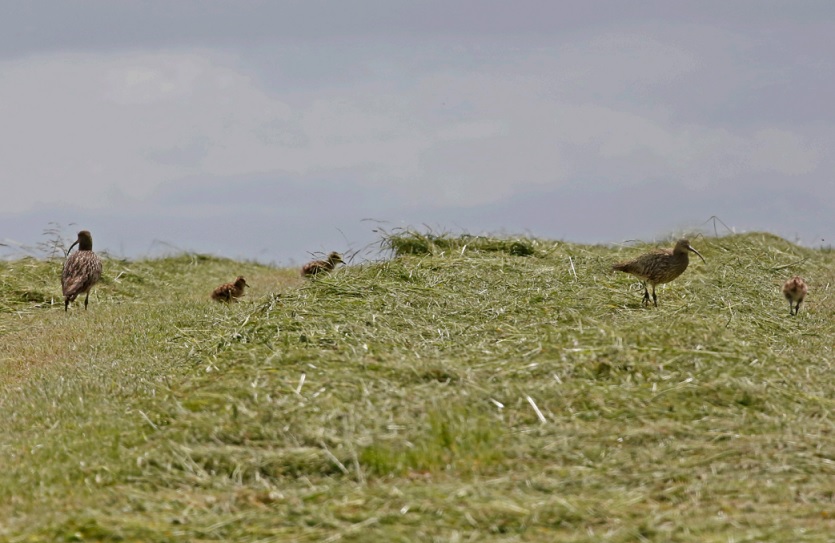News and Information
Further nest fencing
After 5 days of daily, remote observation by 4 surveyors we managed to find a nest with a sitting bird.
Two further fields are currently under close scrutiny for evidence of nesting. In both fields, behaviour suggestive of nest site selection and in one mating has been observed
A nest fencing team went to fence the nest the following day (22/5/25) and found that over the previous 24 hours the nest had been attacked, probably by an avian predator. At the time, it was difficult to work out what might have happened so the nest was fenced.
Two eggs were found, both pecked, along with curlew feathers, a spot of blood and yolk in the bottom of the nest. The two pecked eggs were not the source of the yolk because, in one, the peck had not penetrated the shell and, in the other, the exposed shell membrane seemed to be intact. We concluded that the yolk must have come from a third egg which was broken and then carried way by the attacker.
The adults have not been seen since then and on 25 May, I spent 2 hours watching the nest with no sign of a curlew. It is most likely that after the trauma of the attack and possibly actual physical injury, the pair have deserted. I will keep an eye on the nest over the next few days to see if they have returned. If not, the nest fence will be removed.
Clive White
More nest fencing
We have now fenced two more nests. Fenced on 13 May the approximate hatch dates of these eggs are 13-16 June.
One further field is under close scrutiny for evidence of nesting. This pair may have delayed nesting because of the presence of sheep in this field. Alternatively, the eggs may have been destroyed by the sheep and the birds are starting a second clutch. The farmer has very kindly removed the sheep temporarily and we hope to fence the nest soon to allow the sheep to be returned to the field.
Two further fields are currently under close scrutiny for evidence of nesting. In both fields, behaviour suggestive of nest site selection and in one mating has been observed
The prolonged drought has slowed grass growth and has made nest finding easier than in previous years but I would like to think that our better under-standing and interpretation of curlew behaviour has also contributed to our success.
Clive White
Nest Fencing 2025
We have now fenced nine nests. Fenced between 28 April and 11 May, the approximate hatch dates for these eggs range from 28 May to 3 June.
One further field is under close scrutiny for evidence of nesting. This pair may have delayed nesting because of the presence of sheep in this field. Alternatively, the eggs may have been destroyed by the sheep and the birds are starting a second clutch. The farmer has very kindly removed the sheep temporarily and we hope to fence the nest soon to allow the sheep to be returned to the field.
The prolonged drought seems to have caused problems in other parts of Northern England because the adults are having difficulty feeding on their territories and are spending a lot of time feeding elsewhere. We have seen this in DBCP but so far nesting has not been delayed any more than last year when the problem was wet ground from excessive rainfall.
Clive White
Territories Map
We now have a map showing our best guess at curlew territories this year. It is based on a combination of the pairs recorded together in the fields and the total curlew sightings reported on the Coreo App.
There are a few territories which are uncertain because there are few or no pairs recorded or very few reports of either sex. This may mean one of the pair have not turned up on territory but it may simply indicate a lack of reports for certain areas which are not surveyed frequently.
One historic territory has probably been abandoned because the owner of those fields has begun walking his dog frequently around them.
The core of each territory usually remains unchanged from year to year but the exact boundary varies annually depending on the outcome of territorial dispute between neighbours.
The first mating pair on DBCP this year were seen mating yesterday, so the birds will begin nesting during the next week.
The farmers involved in the project will remove or introduce livestock to certain fields, as agreed recently. This will give us the best chance of pushing curlew to nest where they have the best chance of fledging chicks.
Clive White
Curlew Territories
I confess to being a Luddite and technophobe but I have now caught up and am a total convert to the DBCP Coreo App. We must thank our ecologist Kate Wright and volunteer Neera Johnson for their hard work developing the App for our purposes. The App now contains so much valuable information on curlew behaviour.
We have now sorted most of this year’s territories out and I hope to have a provisional map shortly. Although a few territories remain confused and we seem to have more pairs than territories.
However, we must not let persisting uncertainty over territories distract us. Time and the curlew are rushing on and now we must start looking out for male curlews clearing nest fields of crows etc and clutch guarding behaviour by the pairs. These behaviours give us the best chance of spotting nest sites before everything goes quiet as incubation begins.
Clive White
Return of Pairs to Territories
The first curlew contact calls were heard very early this year, on 30th January and I was beginning to fret that they were taking too long to appear on their territories.
But, today was the first fine day for a while and I heard territorial song for the first time this year. It was over Dairy Lane and I set off to investigate.
I found 3 pairs and a single female had returned to their territories.
These particular pairs are often early returnees. Last year they were first seen on their territories on 25/2/24, 26/2/24 and19/2/24 respectively, which is more or less the same time as this year.
At 16:30 I was alerted by contact calls and looked up to see a flock of 5 curlew heading southwest out of the valley, presumably to their nocturnal communal roosts. I will wait their return in the morning.
Clive White
We win prestigious conservation award
The North of England Curlew Conservation Awards took place on 18 August 2024 in in Masham Town Hall. The event brought together more than 140 farmers, conservationists and land managers including the 17 award finalists to celebrate curlew. The event saw talks, music from the Pennine Hills Curlew Choir, films, photographs as well as the presentation of awards.
The 2024 Curlew Project Group Award
This award recognises partnership working by groups of different stakeholders, including farmers, volunteers, upland managers, ecologists, ornithologists and others, to create connected corridors and patchworks of curlew habitat across the wider landscape, increase understanding of curlew behaviour and trial innovative conservation practices.With many thriving curlew projects across the North of England this award was very competitive with eight finalists. So, we were especially delighted when this award when to our Darley Beck Curlew Project!
Now in our third year, our project on a cluster of lowland farms over about 400ha, has trialled several innovative schemes, from targeted nest field payments to predator exclusion fencing. In 2024, experimenting with bio-acoustic monitoring and trail cameras to build an accurate picture of predator threat, and engaging in creative projects to inspire the next generation of curlew conservationists and farmers. The judges were particularly impressed by the dedication of our 30 strong team of volunteers and the passion of our project manager and founder Clive White, who collected the award on our behalf.
For the full report please open the pdf provided by Matt Trevelyan below.
North of England Curlew Conservation Awards
Delightful photos
I could not resist sharing these lovely photos. They illustrate beautifully the lead up to fledging which I have not seen before, either in real life or in a photo.
The pictures are of two chicks from the same nest at exactly five weeks.
The dark tips to the flight feathers are obvious. In the sideways-on picture the dark tips of the flight feathers have not reached to the tip of the tail and are not fully grown. They will get there at six weeks at which point the chick will become fully capable of flight, ie ‘fledged’.
Clive White
Diary of a single nest
In this update I share our observations from a closely watched nest which had daily observations from a surveyor to the North and another to the South.
The nest was fenced on 12th May 2024 and had three eggs. The fourth egg was laid on 14th May and the chicks hatched on 10th June.
The field was mown around the nest fence on 3rd June. On that day, before the field was mown, a walker on the footpath provoked alarm calls from the male. Prior to then no activity had been observed throughout incubation.
Once the cut grass had been collected up, a flock of rooks, jackdaws, gulls and crows descended to feed in the field around the fenced nest, but they were ignored by the male who was on guard near the fence. However, four curlews also came in to feed and they were systematically driven away.
He was particularly incensed by one that came too close to the nest and later, when I was walking my dog up the footpath on the far side of the field, he came over and flew around me alarming.
The male’s tolerance of the various birds that came in to feed persisted, as well as his intolerance of other curlew, until 9th June when he began to chase away the crows. Simultaneously, the female was feeding near the nest fence.
It is strange that the male was more concerned about threats to his territory from other curlews than threats to his eggs that were about to hatch from avian predators. It is highly likely that he would have known the eggs were about to hatch from the pipping of the chicks inside.
On 10th June when the chicks were due to hatch, the male occupied himself by performing several territorial song flights around the field and the female was seen feeding outside the nest fence.
On that day, there was another male (probably the same male that had been challenging the pair territorially throughout the season) in the field near the nest fence. The two males engaged in parallel walking, darting at each other and at imaginary insects and throwing bits of grass around. The rightful owner of the territory prevailed and gradually pushed the interloper to the top of the field and left him there.
On the 11th June the female was not seen and the male spent the day on guard near the nest, chasing off crows.
On 12th June the male was seen in the field with four tiny (2 days old) chicks. They returned to within the fenced area at 8:00pm.
On 14th June the pair were out in the field with four chicks. A crow was seen to snatch one of the chicks (at 4 days old). Later that day only two chicks were seen.
On 15th June there were two chicks with adults in the field and the male was seen chasing crows. The chicks returned to the fenced area at 8:00 pm.
On 17th June the female and two males (one of them was probably the longstanding interloper) were seen in the field with two chicks. The chicks continued to return to the fenced area each evening at around 8:00pm. Was the interloper functioning as an alloparent?
On 18th June there was a heavy shower of rain, and the female was observed to gather the chicks together under her wings before releasing them when the rain stopped. A delightful piece of behaviour! Two hares that were too close to the chicks were driven away by the pair working together and running at them with necks outstretched. Rare but not unknown behaviour.
On 20th June the chicks went into an adjacent uncut field, returning later to the nest field. The parents kept guard from the wall between the two fields.
On 21st June the chicks went into the adjacent uncut field again. When they returned to the nest field the gateway between the fields was blocked with mesh to prevent the chicks returning to the uncut field which was due to be mown within the next few days.
On 22nd June the pair and two chicks were seen in the nest field and returned to the fenced area in the evening.
On 23rd June at 6:00am there was alarm calling from the nest field which persisted until 10:00am. At 8:45am, five curlew and a magpie were heard alarm calling (mammalian) around meshed gateway. The chicks were predated at thirteen days old, probably by a fox.
On 24th June the pair were still in nest field but disappeared thereafter.
Clive White
Reflecting on nest fencing
The nest fencing and rope dragging season has reached its natural end. We had hoped that we would find and fence second clutches, laid by pairs that had lost their first nests.
Of the five pairs that lost their first clutch, we were able to find and fence only one second nest. I’m pleased to report that this clutch has hatched successfully, and the chicks are now 11 days old.
We could not locate 2 further second nests but despite this, both went on to hatch successfully and the chicks are now around 4 weeks and 10 days old, respectively.
Two pairs did not attempt a second clutch, probably, in both cases, because there were no suitable sites available on their territories when forage harvesting had finished.
Nest fencing takes a considerable amount of effort and aims to protect nests against forage harvesting, livestock and mammalian predators. This year we aimed to fence 6 nests against forage harvesting plus predation and 7 nests against livestock plus predators.
Fencing does protect nests against mowing. Chicks are also protected but only if the field is mown before the eggs hatch. Nests were protected successfully in 4 cases, but we acted too late in 2 because we were unable to locate the nests before the fields were mown.
One clutch hatched before the field was mown but the chicks survived the subsequent mowing because of the diligence of the farmer who spotted the four chicks at 10 days old and moved them to a headland.
The remaining clutch has hatched but at 10 days old they are facing the arrival of contractors in the next couple of days and unless they have moved out of the field when the contractors arrive, they will be mown.
Fencing was largely successful against mammalian predation, but one egg was stolen from a clutch of four, probably rolled away by a stoat. The remaining 3 eggs hatched successfully. Two clutches of eggs were predated a couple of days before we went to fence them because we did not act fast enough.
The main lesson from this first year of fencing is: act fast at first suspicion of nesting.
The next phase of surveying involves finding where the chicks are and establishing their continued survival. They can range over several fields, not always in the original territory, and be difficult to find. A guarding male that alarms at your approach is a reliable sign that chicks are nearby.
Nesting has been up to 2 weeks later than normal this season, due to the wet weather in April and May, so many chicks from first clutches are not due to fledge (6 weeks of age) until the end of July. Two sets of chicks which are from second clutches, will not fledge until the first week in August. Our surveyors will keep looking until the fate of the chicks has been established.
When our surveyors’ see flocks of bereaved parents feeding in freshly cut fields, they will also try to establish the sex of the birds. So far this year, the flocks have consisted almost exclusively of pairs feeding together but I expect this to change. The females are beginning to desert their chicks now, leaving the males to look after them. As these males also lose their chicks, they will leave their territories and join the flocks which will then begin to consist mainly of males. In previous years, the few juveniles that have appeared in these flocks have arrived during the latter half of July.
Clive White
Rope dragging
Our first rope dragging was a success, possibly a fluke!
First rope dragging
The farmer had planned to graze the field with cattle, and we needed to find the nest to stop it being trampled. We had seen some activity on a couple of occasions but the third and last time was a week before we went to drag it. During that week the birds had been seen in the surrounding fields but not in the assumed nest field. I thought this could be the birds’ strategy of not drawing attention to the nest field and deduced that, despite the pair’s absence from the field, they were nesting in there.
The grass was a foot or more deep in many places and the nest was deeply hidden. The bird flew off the nest which, incredibly, was spotted by one of the rope draggers. It contained four eggs.
Because the grass was so well grown, the farmer decided to take a crop of silage rather than waste much of it under the feet of grazing cattle. This made the survival of the chicks less secure but the farmer very considerately offered to leave a large part of the field around the nest fence uncut as a refuge for the chicks. In the end he cut it sooner than expected and before the eggs hatched, so the chicks should be safe for the moment.
Second rope dragging
Our next rope dragging aimed to find the second nest of a pair that had lost their first clutch. After they had lost their first clutch, we had only occasional sightings of the pair in the field to go on. For two weeks all had been quiet. The logic for thinking they were nesting there was the same as in the first case, but further supported by the knowledge that second nests are usually in the same field as the first.
We dragged the field and on the second pass a bird was flushed by the rope but not even our best nest spotter could find the nest. We withdrew from the field to watch for the birds’ return. They returned within minutes to a spot further down the hill which the rope had not reached.
We concluded that during the first pass the bird had been disturbed and decided to ‘do a runner’ through the grass. It only took to the air when it met the rope being dragged down the hill. We decided to allow the birds to settle and to re-drag the field in a few days.
When we dragged the field a second time, we realised we had to catch the sitting bird by surprise with the rope. To avoid disturbing it beforehand, the rope was positioned to catch it on the first pass and dragged from the opposite direction to minimise the distance walked by the draggers to reach the suspected nest site. The plan was successful, and the nest was found in long grass by one of the observers watching the drag. The rope draggers had not seen the exact spot where the bird took off.
Third attempt
The third potential nest field is due to be cut for silage. The birds had been seen only four times in two different parts of the field during the previous three weeks. When we arrived to drag the field, the birds were visible but moving around and clearly not on the nest; possibly, we had interrupted a nest exchange. We abandoned our plan and decided to try again after a few days.
When we returned there was a male wall standing and probably guarding the female who was sitting on the nest. We dragged the whole field but drew a blank during which time the male flew off silently. We deduced from his silent departure that there could be a nest in the field, and he left it silently to watch us from the wall as we arrived at the field; we had lost the vital element of surprise. We can deduce with certainty that there were no chicks in the field because there were no alarm calls. Either there is no nest, or the birds are still sitting.
Do we drag a second time? We need to decide soon because with the usual mid-summer spell of good weather coming up, the farmer is going to want to cut the fielding in the next day or two.
I recount all this in detail, as contrary to my initial expectations, rope dragging has proven complicated and we need to document and learn from our early experiences.
Clive White
Are nest fences doing their job?
The first nest we fenced this year was fenced on 30 April. It was in a field next to where, 3 days beforehand, we had gone to fence a nest too late, and discovered it had been predated by fox.
The trail camera in the gateway to the field that was fenced on 30th April caught a fox leaving and a badger entering the field on 10th May. At this time, the birds were almost halfway through incubation. The eggs hatched successfully on 29 May and chicks were seen in the field, near the nest site, on 31st May. Clearly, neither the fox nor the badger had found the eggs and I believe the fence protected the eggs successfully.
A few days later (3rd June), 3 chicks were seen in the vicinity of the nest fence, so we can hope that the chicks are using this as a refuge that will protect them when the fox and badger inevitably return to the field.
The use by the chicks of the long grass inside the electric fence as a nocturnal refuge has been reported by one of the continental curlew groups with long experience in nest fencing. I’m not sure how strong the evidence was but it would be nice to think it really happens.
The main advantage of nest fences is to allow farmers to take an early cut of silage without risk to the eggs, provided the field is cut before the eggs hatch.
If the field is cut after the chicks have hatched, small chicks are unlikely to survive because, at that age, their response to the calls from their parents is to crouch still. After they are a couple of weeks old, they learn to move away from danger and they are bigger and more easily seen. Their survival depends on the sharp eyes of the tractor driver coupled with his awareness that there are chicks in the field and his willingness to stop and climb out of the tractor. Many farmers will do this, but most contractors will not, because for them, time definitely is money.
Clive White
Early flock formation 2024
In June 2022, I shared the following thoughts on early flock formation:
Flocks of curlew have begun to appear on freshly mown fields in the surrounding countryside. It is too early for these to be dispersal flocks which are formed by fledged chicks and their fathers before they leave the breeding areas for the winter. Such dispersal flocks usually appear at the end of July.
I went to investigate a couple of flocks on Penny Pot Lane in adjacent freshly mown fields. There were no juveniles present, which rules out dispersal flocks. The sexes were equally represented and were mainly in pairs, feeding a few feet apart.
They would seem to be pairs that have lost their chicks during mowing in the surrounding countryside and have abandoned this year’s attempt to breed.
This year, 2024, the same holds:
When returning from work yesterday, I noticed a large flock in the fields on the opposite side of Penny Pot Lane, which may have been 100 strong. I returned the next day to check on the sex of the birds making up the flock. The flock had reduced in size and consisted of 16 pairs, just as described in June 22.
Mowing began a couple of weeks ago and these birds are almost certainly pairs that have lost their chicks during the process of forage harvesting.
I anticipate, in the light of other observations made in 2022, that the composition of the flocks will change to predominantly males in a few weeks, when the females desert their families.
The females will desert their young when the chicks are around 3 weeks old, but the females do not flock and there will be few seen in the dispersal flocks. They disappear immediately to rebuild their fat reserves ready for next year’s breeding season. The flocks will become almost exclusively males that have lost their chicks to predation or agricultural activity, subsequent to their desertion by the females.
I will try to monitor these flocks during the following weeks of the breeding season.
Clive White
Looking ahead
We still have approximately ten more nests, including three second clutches, to find and fence but the season is rushing on and in the next couple of days our first nests are due to hatch.
For some weeks, the birds have been quiet, trying not to attract attention as they incubate their eggs, but all will change when the chicks hatch. The newly hatched chicks’ small size makes them vulnerable to a wide range of avian predators. As well as the usual suspects: crows and buzzards, many birds previously considered harmless such as jackdaws, magpies, kestrels, owls, red kites and any species of gull, will be noisily and aggressively driven off the nest field.
The male usually does the flying when potential predators are driven away and the female stays on the ground with the chicks, alarm calling from there. If the male is struggling with a particularly persistent crow or buzzard and there are no neighbouring males to help, she will join him in the air.
Any mammalian predators, including people, will be greeted by a particularly frantic “chak-chak-chak” alarm call and a distraction display by the male to draw the predator away from the chicks. If you want to see the chicks, ignore the distraction display and look for the female. Having said that, for the sake of the chicks it is better to withdraw and allow the birds to settle down.
After a week or two this behaviour diminishes as the chicks increase in size and become less vulnerable. Buzzards and lesser black backed gulls (fortunately, we don’t have them in the main project area) are always a threat, but even crows become tolerated by the adult curlews. In the absence of predators, the adults will be seen wall standing, watching over their offspring.
When the chicks first hatch, they are brooded by the female for a couple of days, to keep them warm. They then leave the confines of the electric fence and spread out in the nest field. Probably guided by their parents, they look for good places to feed which they often find in fields containing plenty of livestock, dung and insects. It has been reported that they return to the fenced area around the nest to use it as a nocturnal refuge, but this might just be wishful thinking. The search for food often takes them across roads, where they are at risk from traffic, hence the roadside warning signs in Hartwith and Dallowgill. Tracking the family across the countryside can be difficult. Usually, they remain on their territory, but they will go where they must go to find food and can travel a long way. The key is to locate the adult who is guarding them.
If curlew lose their chicks to predation or mowing, as soon as they have confirmed the loss, usually within 24 hours, they leave the territory which will become silent. The persistent presence of an adult on a wall top, especially if it is alarm calling, means that at least one chick remains alive.
When the chicks are approximately three weeks old the female will desert them and leave them in the care of the male. This is an exhausting time for the males which can visibly lose weight. They must guard the chicks’ day and night, drive away predators and find time to eat and sleep themselves. The enormity of the solitary male’s task may partly account for the fact that in previous years most of our chicks have been lost to foxes at 3-4 weeks of age. If chicks are lost while under the male’s care, he too will then leave the territory.
The chicks will become safe from predation when they are able to fly properly. They grow their primaries (flight feathers) between five and six weeks of age. They may manage to scramble over a wall, but until they are at least six weeks old, are not capable of sustained flight or taking off fast enough to avoid an agile predator such as a fox or cat. If their father disappears before then, they will have been predated. Six weeks of age is when we consider them to have fledged. At this point the male will leave the territory. The chick may leave with the father but often stays around on its own for a couple of weeks longer.
Be prepared for grief and depression when chicks are inevitably lost but keep surveying, if necessary, on other surveyors’ patches. We need all the information we can get to solve the problems that grassland curlews face.
Clive White
Reflections on the current nesting season
This season, where we have precise dates for last year with which to compare, clutch laying and/or incubation have been 8-10 days later. The exceptions where laying has been earlier this year, have been those nests that were delayed last year, by the presence of sheep in the field. The most likely explanation for the general delay this year is the heavy rain this Spring and the birds’ understandable reluctance to lay their eggs on wet ground.
Nest fencing
We have now fenced six nests. Four contained full clutches of 4 eggs. The remaining two nests had not finished clutch laying and contained 2 eggs and 3 eggs.
We misjudged the nest with 2 eggs, believing the female to have completed her clutch. The 3 egg nest could not be seen until close by and the birds gave us few clues but when the female was last seen, 4 days prior to fencing, she looked to be clutch laying.
We have had 2 failures:
The first nest we tried to fence was predated. The whole clutch had been carried off, almost certainly, by a fox. I had waited too long, watching the female sitting for a week, before deciding to act.
The second failure was probably not within our control. The nest was approximately 50 metres from a busy Public Footpath and the female began laying over the May Bank Holiday weekend, which was very sunny. The footpath was busy with walkers, Duke of Edinburgh Award teams and gangs of noisy cub scouts. On one occasion, I remonstrated with the cub leader after seeing some of the group running about in the field, off the footpath. This all proved too much for the female who deserted after laying one egg which, unprotected, was eaten by a crow the following day.
The loss of the first nest persuaded us that, to protect them from mammalian predators and livestock, nests should be fenced as soon as there is reasonable evidence of nesting.
Our foray into nest fencing has given us many useful insights into the behaviour of curlews. The most important is confirmation of the excellent fieldwork of a number of our surveyors, which allows us to predict clutch laying and incubation with confidence, based on their observations of the birds’ behaviour.
Incubation
We are now entering the incubation month when the birds, literally go to ground and we will no longer have much behaviour to guide us to the whereabouts of the remaining nests. The growing length of the grass will make spotting a sitting bird almost impossible. Most of the remaining nests will be found by observing nest exchanges.
There are two types of nest exchange, Furtive and Blatant:
Furtive exchanges occur when the birds know they are being watched by a surveyor or potential predator. If you can see them, even with binoculars, they will know you are there. You may remain undetected by the birds, using binoculars from within a car that is parked a couple of fields away, and witness a Blatant nest exchange but the best means of observing this behaviour is using a telescope from 300-400 metres away.
During a Furtive nest exchange the sitting bird will try to leave the nest unseen, by running through the grass, often along the side of the field near the base of the wall. Alternatively, it will leave by flying silently and low, in a straight line, to the far side of the field. To locate the nest, don’t look where the bird has gone, look to where it came from. The bird taking over incubation will arrive a distance from the nest and walk slowly and tortuously to it, often stopping with neck erect to watch for danger. It can take some time!
Blatant exchange is often heralded by a short burst of song from the incoming bird, to alert its mate as it flies into the field and usually lands near the nest. The incubating bird will come off the nest as its replacement arrives and fly off silently.
I estimate there are approximately ten more nests to find and locating them will be much more difficult.
Clive White
Two more nests fenced
Yesterday (6th May) we fenced two more nests. The first was fenced after observing a nest exchange on two successive days. The birds had already begun incubation and as expected, there was a full clutch of four eggs.
The birds at the other nest were not incubating but we guessed the clutch was complete. We were wrong; the nest contained only two eggs. The imperative in this case was to protect the nest from egg eating sheep. This pair had lost their first clutches to sheep in two successive years.
I am pleased to report that birds returned to both nests within 15-30 minutes of us leaving the field.
If you look at the three accompanying pictures, you will see that the nest with two eggs is the size of a saucer but the nest containing four eggs and the predated nest are more like a dessert plate. In both cases the area of the nest is the size needed to allow the camouflaged eggs to fill the nest.
This illustrates my contention that when a new egg is added to the clutch the nest is enlarged to accommodate it, but no more. An empty nest, a patch of bright yellow grass the size of a dessert plate in the middle of a green field, is very obvious to an overflying crow. What is the point of having camouflaged eggs unless they hide the yellow grass underneath? It also allows us to conclude that the predated nest contained a complete clutch when predated.
When you watch a female that is egg laying, there is a lot of straining, as would be expected, but there is also a lot of pecking and rearranging grass.
The final photo is of fox footprints found in a muddy gateway into the field where the nest reported in our 29th April update was predated. This is strong circumstantial evidence that supports our suspicion that the culprit was a fox.
At the moment, there are five further potential nests under close observation, which we will need to fence when confirmed.
Clive White
Our second attempt at nest fencing
We checked the suspect nest reported in the last update twice on 29th April. The first time, the female was shuffling about and rearranging pieces of grass. She appeared to have just laid an egg and we guessed she had completed her clutch. The second
time, we saw the female, she was feeding in the field away from the nest and the male was feeding in another field. We concluded the pair had not begun
incubating.
I have learnt from watching the curlews in one of my own fields that it is often unclear when egg laying ends and incubation begins. For 2 or 3 days the female will intermittently sit on the eggs before incubating in earnest.
The weather forecast for 30th April was good and I decided that today was the day to fence the nest. The female was not on the nest, and I failed abysmally to locate it but one of the team joined me and pointed out that I had walked past within 3 feet without seeing it. There were 4 eggs which indicated it was probably a first clutch.
We managed to fence the nest within 30 minutes of entering the field. The grass was longer than we thought, and strimming took longer than the rest of the tasks. When I checked the nest this afternoon, the male flew singing into the field but I couldn’t see the female which, I hope, was on the eggs, hidden by the grass. I will check again tomorrow.
I opted not to put up a nest camera because the Hartwith Curlew Project has reported desertion by a pair which was still laying and had only 2 of the normally 4 eggs in a complete clutch. The consensus of the Northern Curlew Group was that the erection of a nest camera, before the birds were fully committed, was an intrusion too far.
I have recounted our first (so far successful) nest fencing in such detail because I had not anticipated, as a first-time nest fencer, the many things to be considered. The biggest lesson for me was the difficulty of locating a nest in the middle of a field of long grass and the importance of identifying as many landmarks as possible, to give the best chance of finding an unoccupied nest. A tuft of flowering sedge, its relation to some clumps of rushes and a nearby patch of longer, greener grass in which the nest lay were vital clues.
Clive White
Update on nest fencing
On 27th April 2024 we went off to fence a nest in one of our fields. The weather was perfect. The female had first been seen sitting on 17th April. I thought then that she was probably sitting down out of the wind but on each of three further checks, the last one on 24th April, she was still sitting in the same place. I was particularly pleased because I had predicted this as a probable nest field and the farmer had agreed to keep his sheep out until the birds had nested and we could fence off the nest.
Unfortunately, when we arrived in the field, the nest had been predated. There was no trace of any eggs, which makes a fox the most likely culprit. We packed up the gear and left, disconsolate.
This pair is especially unfortunate. Last year they lost their first clutch and were seen mating on 16th May 2023. They had re-laid by 25th May 2023 and successfully hatched chicks from their second clutch around 20th June 2023 but sadly, the chicks were predated at 10 days old.
When we were leaving the field on 27th April 2024 we noticed a male curlew crow-chasing on two occasions over an adjacent field. This is sign of clutch laying and it raised our spirits, particularly because this field was another probable nest field from which the farmer had agreed to exclude his stock.
We checked this field twice that afternoon and again on the following day. On each occasion, the female was either on the wall nearest to the probable nest site or in the field very close to it and very alert to our presence on the lane. I think she is still clutch guarding and has not finished laying.
Although it is reported to be safe to nest fence during clutch laying, I would like to be more certain before I set about doing it. On the other hand, I don’t want to delay too long and have the fox strike this nest as well. I plan to check what is happening today (29th April) and will have to make the difficult decision!
Clive White
The curlew nesting season is rushing upon us
Mating displays: conga dance, back pecking and mounting, short of actual mating have already been seen by surveyors on six occasions. These truncated, ‘practice’ displays will be repeated by each pair until full consummation before the eggs are laid. They are part of the pair’s bonding process.
Today, I witnessed the “Real Deal”; this was a prolonged mounting, wing flapping performance by one of ‘our’ pairs. I don’t know how long it takes from mating to fully shelled egg in curlews or whether mating needs to be repeated to fertilise each egg in the clutch.
Does the female have the ability to store the sperm from the male and fertilise each egg as it is formed? Can anyone help me with this? I’m hopeful that this pair may start to lay in the next 10 days.
See Youtube Video for a great video of one of the pairs on Dairy Lane captured by Barry Carter a couple of days ago.
Until recently, most territorial song displays have been performed by the male alone. An up and down song flight repeated in ever increasing circles over a wide area of land centred only approximately over his self-proclaimed territory. It seems to be a challenge to neighbouring males.
Another display has become prominent in the last couple of weeks. It is a joint territorial song display, in which the pair fly side by side over their territory, with both birds singing and landing together in a field on their territory. It seems to be a confirmation of their ownership and probably helps the pair to bond together and with their territory.
Clive White
Curlews reoccupying territories
We have now managed to define the territories reoccupied by pairs of curlew this year. In the project area we have identified 12 territories that were occupied last year. Two remain to be filled.
In Mid-April, the pairs will start to mate. Mating begins with the female leading the male in a conga-like dance around the field, walking a sinuous route through the grass. As the dance progresses, the gap between the female and the pursuing male narrows and he starts to peck her on the back as they walk. He may eventually mount her but initial matings are often brief and unsuccessful and the birds quickly return to feeding. Successful matings last several seconds and sometimes the female continues walking with the male, flapping his wings to keep his balance, still on her back. The field where they mate is usually on the pair’s territory but does not indicate where they will nest.
A few days after mating the pair will decide where to nest and this often involves a prolonged dialogue between the two birds. The male will suggest a site by shuffling down in the grass, pecking off grass stalks and throwing them over his shoulder. While demonstrating the nest site he has chosen, he makes eye contact with the female who is watching from a few yards away. He is reported to call quietly to her with something resembling a lost chick call (Harry Ewing, BTO) but Clive has never been close enough to hear this. The female will then go across to inspect the site, squatting down and pecking off some more grass stalks. Often she will reject the male’s choice, get up and walk back to where she was originally standing. This sequence will be repeated until the female accepts the male’s proposed nest site.
In the third week of April the female lays her clutch, which is usually four eggs. This takes 3-4 days and, to ensure all the chicks hatch at the same time, she only starts to incubate once the clutch is complete. While the clutch is being laid the eggs lie in the nest exposed to the gaze of any passing crow. To protect the eggs, the pair tend to stand in the field near the nest (another useful clue), so the male can take to the air helped, if necessary, by the female, to drive off any crows that might overfly the field. This short period of intense crow chasing is an important sign of nesting and indicates the site of the nest. This clutch guarding behaviour abates once the birds start incubating and the eggs are hidden by the sitting bird. If the surveyors have not located the nest at this point, the sitting birds will disappear from sight as the grass grows, and finding the nest will become increasingly difficult.
Crow chasing does also occur earlier in the season but it is done with less commitment and intensity than during egg laying.
First Curlews of 2024
The latest update from Clive White. As you’ll see the focus of this one is key dates and curlew behaviour at these points, with a heads up of the timing of key activities for our brilliant surveyors
- 2 Feb - first flock of the season
- 7 Feb – first curlew in the DBCP area
- Mid-March – curlews reoccupying their territories
- Mid-March – mid April – surveyors determining the number of territories and their locations
- Mid-April – mid-May – surveyors finding the nests
Click the link below to view the full document(pdf) in your browser:
DBCP Update Feb 14 2024
Thoughts on farm payments - Jan 2024
While we await the return of the curlews, Clive White shares his thoughts on farm payments for curlew conservation in the wider landscape, which as you will see looks at:
- Prevention of range contraction
- What do they encounter in the Pennines that allows them to survive and breed successfully?
- Can these conditions be provided in the wider countryside?
- What are congenial farming practices?
- Why is invertebrate food important?
- What is adequate cover?
- Lowland grassland farms are very different to upland farms.
- Can the conditions favouring curlews in the uplands be replicated on intensive lowland stock farms?
- How should these modifications of agricultural activity be funded?
- What can be done to limit predation in the lowlands?
Click the link below to view the full document(pdf) in your browser:
Thoughts on Farm Payments Jan2024
Summary of DBCP breeding season 2023
A total of 16 territories occupied by returning pairs of curlews. 14 of these pairs nested. We lost track of one pair and the female of another disappeared. 11 of the 14 nest sites were located. In three cases nest fields were identified but the precise location of the nest was not established.
Two nests lost the first clutch. One of these was probably predated by crows and one probably by sheep. Both pairs laid a second clutch. One of these clutches hatched but the other was destroyed again by crows. Thirteen nests (including 1 second clutch) hatched successfully.
If we excluded predatory sheep, no nests or chicks were lost to agricultural operations. All sets of chicks were predated subsequently, with loss of all or some of the chicks. The last chick in each clutch was lost at between 5-35 days of age (mean 26 days). Only two chicks survived to fledge successfully at 43 and 45 days.
The nature of the predator involved is uncertain. A variety were caught on trail cameras in the project area, but the number of sightings does not necessarily reflect the number of predators. Badgers were the most common with 23 sightings but they are creatures of habitat so the same animal may have been photographed on multiple occasions. The same applies to foxes (18 sightings), cats (15 sightings) and stoats (8 sightings).
We suspect that the main predator in the project area was foxes. Examination of the pictures from the trail cameras and our surveyors’ observations revealed a pattern: the only occasions when foxes were seen more than once a night near four nest fields the chicks disappeared one or two nights afterwards following a further visit by a fox.
Updated DBCP poster prepared for the 2023 Nidderdale show. Click the link below to load the poster in your browser:
Nidderdale Show Poster 2023
Should we do anything differently in the DBCP area 2024?
Many meadows in the project area are dual use: they are grazed early in the season then closed up for a forage crop which is usually cut mid to late June. In 2023 the management of whole fields was changed to accommodate nesting curlew. The consequent restriction on grazing and the loss of high-quality silage due to delayed cutting had financial costs that were difficult to compensate fully.
Is there a place for nest fencing? If livestock were removed from such dual use fields in mid-April, the curlew would nest in them within a couple of weeks. If the nests could be found and protected by a 20x20 metre electric fence the meadow could then be closed up for silage after the stock were removed in mid-April. In favorable seasons the grass may grow sufficiently to allow a first cut in May. This could be done without harm to the curlews, provided it was done before the chicks hatched in late May. Thereafter the grass should have regrown enough for a second cut in July by which time the chicks would be about to fledge and would be capable of avoiding grass harvesting machinery.
Alternatively, if a field needed to be used for grazing, the stock could be returned safely after the nest had been fenced. If it was closed up at a later date for a grass crop this would have to be cut after mid-July when the chicks would be about to fledge. If a field was scheduled to be grazed after the nest has been fenced, the fence could be removed after six weeks when the chicks would be two weeks old and big enough to avoid trampling by the livestock.
We have begun to discuss these changes in management with the farmers and landowners and hope that we can introduce them for the 2024 breeding season. We are hoping that some of our surveyors will volunteer to be trained by the Hartwith group to undertake the nest fencing. And want to strengthen our links with the Hartwith project generally.
We also must reduce the level of predation of curlew chicks and are in close discussions with conservation organisations (GWCT, RSPB, BTO), and other stakeholders to come up with acceptable policies.
First Chicks!
Our first chicks, that we’re aware of, hatched on 25-26th May and a chick was seen with its parents on 27th May.
Hopefully, many others will soon follow. From our nests watched closely during the egg laying process, we estimate hatching dates from 30th May to 6th of June.
Sadly, we know one nest lost its eggs due to predation. The pair renested in the same field on an area cut and baled for silage. They mated amongst the cut grass, re-laid immediately once the grass was baled and started incubating before the bales were cleared from the field. There is a large uncut area of the field where they could have re-nested. But they chose the cut area with no cover, convincingly demonstrating curlews’ preference for short grass.
We will share information about other failed nests when adults are seen remating or chicks fail to hatch.
We lost another nest to chain harrowing within a few days of the pair beginning to lay. Again, the pair have chosen to re-nest in the same field, which still has short grass and little cover due to prior heavy grazing with sheep.
There are probably other pairs that lost their nests during recent mowing on one farm. But happily, one of our surveyors located another nest on this farm and informed the farmer. So far this has remained undisturbed.
With the first crop of silage already taken on farms outside our Project area, many curlews nesting on fields shut up early for silage have already lost their chicks and given up on breeding this year. They can be seen as a flock of around 50 birds with equal numbers of males and females, feeding on freshly cut silage fields on Dacre Lane.
Tragic and so depressing to see!
Clive White, Darley Beck Curlew Project Manager.
Chucking Stuff about
In this story, Clive shares hid thoughts about this behavoir.
Many surveyors reported seeing curlews ‘chucking stuff about’ both last year and this season. Its significance escaped me until recently. It seems to occur during aggression between curlews and as part of nesting.
Agression
During aggression it is a displacement activity. The human equivalent would be punching a wall in anger or frustration. I have seen it during territorial disputes between male curlews. Usually, these disputes are manifest mainly as parallel walking and chasing with beaks pointed threateningly. Periodically during these disputes, they will pick up grass, twigs, moss or even pieces of silage wrapper and throw them around. If this displacement activity fails to defuse the aggression, it can progress to physical violence: battering with wings and scrabbling with feet.On one occasion, we witnessed aggression directed by a female towards a male. The female seemed to resent the presence of the male and kept attacking him with beak outstretched. At times, during pauses between these attacks, the male was seen to throw stuff about, presumably an attempt to reduce his own aggressive response.
Nesting
During nesting ‘chucking stuff about’ has a different function. Prior to nesting, the pair need to choose a nest site. The male will select a suitable spot and signal this by starting nest building. After making a depression in the grass by pressing it down with his breast, he adds to it pieces of vegetation picked up from within reach of the site. Unsuitable pieces of material will be thrown away over his shoulder. When he is done, he looks at the female and she walks over to inspect the nest. If it’s not acceptable she walks away, and the male must find somewhere else.When he has found the right site, the female will take over the nest and augment it with her own nest building activity which is more of the same. The initial nest is barely big enough to contain the first egg and is enlarged by the female prior to the laying of each additional egg until the clutch of four eggs is complete.
Incidentally, it’s incorrect to believe that a curlew’s nest is just a depression in the grass. Although rudimentary in comparison with many other bird species, it is a deliberately constructed structure. Inspection of a curlew’s nest will reveal a base of dead leaves and stalks and around the margin will be seen stalks cut through to clear a tea plate sized space in the grass for the nest.
The plight of grassland curlews
DBCP poster prepared by Clive White for Pateley Show last year.
The poster provides a useful overview of:
- The current population declines of grassland curlew due to poor breeding success and chick survival
- Some of the reasons for this including predation, stocking densities and timing of agricultural activities
Last year our focus was monitoring to find out more about the plight of our Darley Beck curlews and more about the extent of predation/activities affecting them.
As you heard at the recent meeting, this year we are using this information to work in collaboration with farmers and landowners to develop bespoke management plans for specific fields with the aim of managing these in a way that will be more favourable for curlew.
Together with the monitoring by our team of volunteers we can monitor how the curlews fare this year.
Thank you all in advance for your support.
Click the link below to load the poster in your browser:
Plight of grassland curlews
(Large file, give it time to download).
Looking for funding
Year one has confirmed our fears of poor curlew breeding success in this valley. Of 25 nests, producing around 100 chicks, only one chick was known definitely to have fledged. Five chicks on the periphery of our project area may have fledged, having moved into other parts of their territory that were not included in the study area. To maintain the population at its present level each pair needs to produce 0.5-0.6 chicks per annum.
No nests that we know of were lost at the egg stage. On around one third of the project area chick losses were due solely to predation. Most chicks disappeared at 3-4 weeks of age, mostly killed by foxes. This happened towards the end of June, presumably when growing fox cubs forced the parents to range further afield to support their increasing dietary needs.
On the remaining two thirds of the area a combination of predation and agricultural activity was responsible for the loss of chicks. Grass harvesting when the chicks were too young to escape either the mowers or the avian predators attracted to the agricultural activity was a major cause of chick loss.
Surprisingly, heavy stocking with sheep proved to be another agricultural cause of chick loss, albeit indirectly. Nesting curlew do not like sheep and movement of large flocks of sheep from field to field disrupted the birds’ nesting plans. Unfortunately, when fields were finally shut up for silage, nesting had been delayed to a time when hatching coincided with grass cutting, at which point the chicks were killed. However, it was clear that livestock do provide important feeding areas and the parents often led older chicks to feed in fields containing cattle or sheep.
The average territory of each pair was ~11 hectares and the average nest field was ~2.5 hectares. To be acceptable to the curlews for nesting, the fields needed to be grazed in spring to keep the sward low. We discovered that curlew will not start to nest in long grass or mature rushes but before egg laying begins, the livestock need to be removed from the nest fields. The curlews seem to accept that, during incubation, the grass will grow and provide cover for the curlew chicks when they hatch one month later. Unfortunately, a fully grown silage field does not seem to be the best food source which is, presumably, why the parents take the chicks into other fields to feed, exposing them to increased risk of predation.
Curlews are very faithful to their nest sites. Year after year they tend to return to the same nest field provided the conditions on the ground remain suitable. If they find long grass or a large flock of sheep in their usual nest field, they will choose another, though not always ideal, field in their territory. We can use the knowledge gained from the first year of our project to prepare the birds’ nest fields to meet their requirements, thus ensuring, as much as possible, that they will nest in those particular fields.
We used this knowledge to develop a detailed Darley Beck Curlew project proposal for FiPL (Farming in Protected Landscape) for 2023. The proposal developed with the support of Farming in Protected Landscapes Officer, Matthew Trevelyan, uses early grazing of the traditional nest field and removal of livestock prior to nesting, to attract the birds back to that particular field. Subsequent absence of further disturbance and late mowing of that field will give the birds the best chance of fledging chicks. A bespoke management plan, tailored to the individual holding can be agreed with each farmer. Should the birds not be seduced to nest where planned, the proposed scheme is flexible enough to be adjusted, in real time, to accommodate their alternative choice of nest field. This focussed process confines the disruption of normal agricultural activity to the nest field, thus reducing the payments necessary to compensate for that disruption but, at the same time, allowing them to be sufficiently attractive to recruit farmers to the Project in future years.
Unfortunately, DEFRA have advised that they will not be able to fund the proposal in its entirety as it differs from existing agri-environmental schemes and might undermine them by better rewarding the farmers. However, we hope that they may still agree to fund some of the proposed activities. At our meeting to review the first year’s results we were strongly encouraged by participants enthusiasm and determination to progress the Project. Therefore, the project management committee is currently seeking alternative funding to support the Project in the coming years.
Clive White, Darley Beck Curlew Project Manager.
8th September 2022
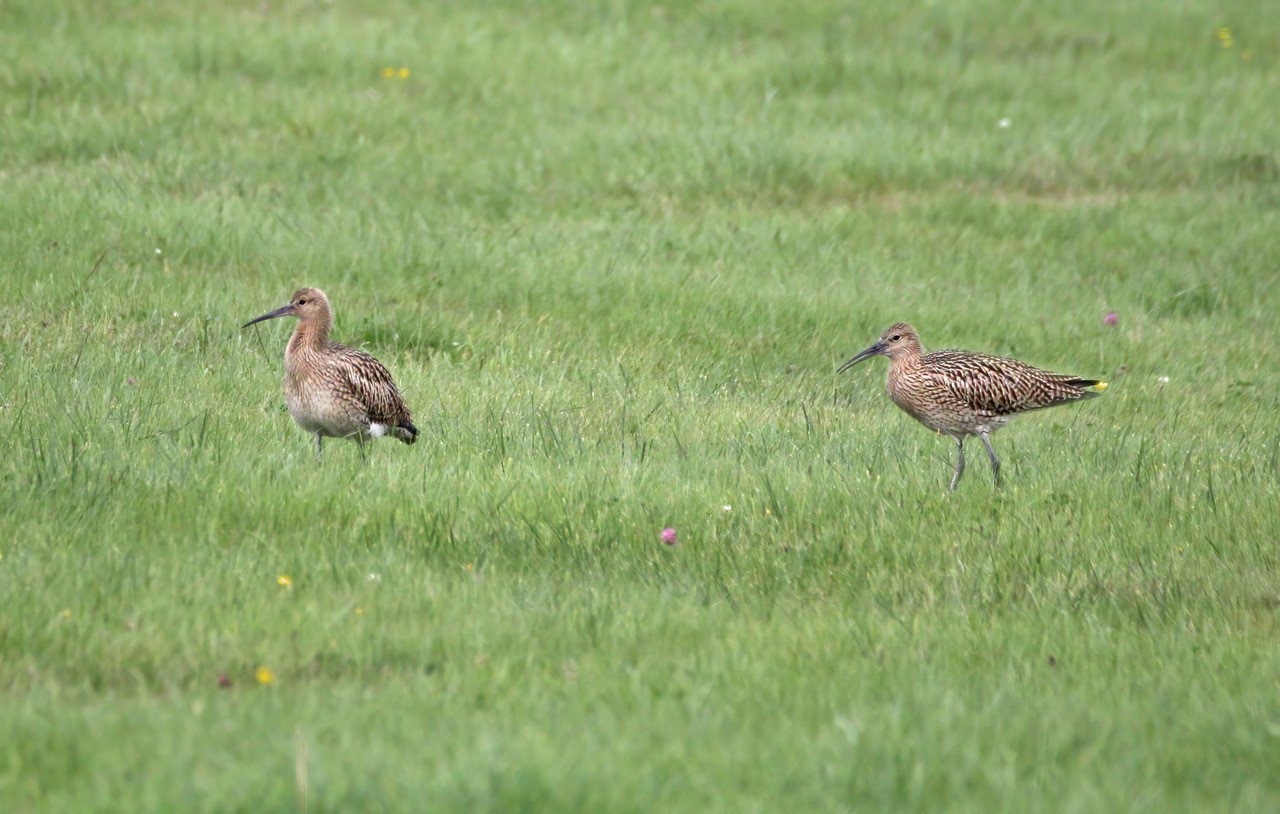 Two juveniles seen in dispersal flock in the upper Washburn catchment
Two juveniles seen in dispersal flock in the upper Washburn catchment
Picture courtesy of Kelvin Smith
Dispersal Flocks
The first local flock of curlews this breeding season was seen alongside Pennypot Lane on 22nd June.
At this time our Darley Beck Project area chicks were between three and four weeks old, too young to have fledged. There were no juveniles present in this flock.
It was mainly pairs of curlews, either non-breeders or, more likely, bereaved parents that had lost their chicks during the grass mowing that had begun outside our project area the previous week.
Over the next couple of weeks, the composition of the flocks changed to predominantly male birds. These were probably males that had been left in charge of chicks by deserting females but had subsequently lost their offspring and then left their territories.
Eventually, a flock of around 70 curlews appeared in the field opposite Four Lane Ends Farm Shop. This did contain two juveniles. There may have been two or three more juveniles, but they were asleep with their beaks hidden so this couldn’t be confirmed.
Most of the flock was male birds. The low number of juveniles probably reflects the poor breeding success of curlew in the grasslands of this part of the AONB.
The only chick that we know for certain fledged from our Darley Beck Project area left with its father on 29th July.
On the first of August a flock of curlew was spotted in the upper catchment of the Washburn that had a high proportion of juveniles, but it flew off before these could be counted. It’s likely that these birds came from the adjacent moorland.
Choosing nesting sites - what curlews don’t like or need
In this update, Clive shares some more of the things our surveying and monitoring this year have revealed.
Curlews are not keen on nesting in long vegetation
Curlews like to begin incubating their eggs in short grass which gives them a view of their surroundings while sitting on the nest. But they start to incubate at the beginning of May when the grass starts growing rapidly. This means that by early June the chicks will hatch out into grass that may be a foot deep. Also, that if a field is not grazed before the curlews start to nest and is shut up for silage too early, the grass may be too long to appeal to curlews as a nest site.To make it more complicated, curlews do not like livestock
Curlews will nest in fields that are lightly stocked with sheep but not when the fields are heavily stocked. Where the difference between ‘light’ and ‘heavy’ lies may be revealed by analysis of the surveyors’ sheep counts. My impression is that although curlews are less tolerant of cattle than sheep, they will cope with very sparse cattle numbers. Again, the surveyors’ results may indicate how many cattle the birds will tolerate when nesting.Once chicks are a couple of weeks old livestock is no longer a deterrent
On the contrary, curlew seek out fields containing livestock for their chicks to feed in. Unfortunately, there are adverse consequences of livestock movements. Movements of sheep or cattle from field to field, as the grass is exhausted, disrupt the curlew’s nesting plans. When they finally settle to nest in a chosen field, the chicks will hatch later than normal and will be younger and more vulnerable to forage harvesting. We know, for certain, that three nests of chicks, whose hatching was delayed by such stock movements, were killed during grass mowing when they were a few days old. All three sets of parents disappeared from their territories the day after the fields were mowed, indicating that their chicks had died in the process.
Curlews do not need badly timed agricultural activity
Harrowing and rolling are totally destructive of curlew nests because they cover the whole field, apart from the headlands. These should be carried out before mid-April when the birds begin to nest. If a clutch of eggs is destroyed by agricultural activity, the female curlew will lay another clutch. But when the chicks hatch, they will be a couple of weeks younger than they should be and more vulnerable to mowing.Mowing is extremely dangerous for young chicks. Chicks older than four weeks can usually move fast enough to avoid mowing. So ideally, mowing should be after the beginning of July. If contractors with two tractors, each with two mowers, are working simultaneously to cut a field in a couple of hours, chicks of any age, that cannot yet fly, will be unable to get out of the way.
However, fertiliser spreading, liming, slurrying, and muck spreading are less destructive. Some nests will escape damage from such activities, provided they are not run over by the tractor wheels. Some birds sitting on eggs will sit tight during these operations. But it is probable that many will desert, especially if it happens early on in incubation. Remarkably, the only chick known to have fledged from the project area survived liming during incubation, mowing when a few days old and muck spreading while a chick!
Finally, curlews cannot tolerate people
Including curlew surveyors, or dogs ranging around their nest fields. But they do get used to both people and dogs provided they stick to regularly used public footpaths.Project highlighted in Yorkshire Post
One of our volunteers, Barry Carter, has featured in an article detailing the plight of curlews in our catchment area.
Click on the link to view the article
YP Article 060822
(Large file, give it time to download).
Reflections on the 2022 season
In this update, Clive reflects on a number of things we have discovered from our surveying and monitoring this year.
Our beliefs on curlew’s favoured nesting places proved very wrong
At the beginning, led astray by published articles, we would inspect a rushy field and declare it to be an ideal field for curlews to nest in. It turned out that none of our curlews nested in fields that contained unbroken mature rushes. This is counterintuitive: why would they not like long vegetation where the eggs and sitting bird could be hidden from the view of predators?It seems that curlews like to lay their eggs in vegetation that is around 10-15cm long so that when they start to incubate, they can see out over the surrounding field. Of course, by the end of May, when the eggs hatch, the grass is 30cm long and is then ideal for the newly hatched chicks to hide in. The best arrangement from the curlew’s point of view is a grass field that has been grazed until the middle of April which keeps the grass short, then the livestock are removed, and the field is shut up to grow the grass for forage. It seems that curlews would prefer not to nest in fields containing livestock, which is probably why they are attracted to fields destined to be cut for silage.
We also thought that curlews like to be away from trees, stone walls and footpaths i.e., in large fields, so their nests are well away from lurking predators or people. A number of nests were found that were in large fields but were also close to trees. Many nests were in small fields and/or close to walls. Four were near footpaths, in one case within 30 yards of the busiest footpath in the Project area.
In some cases, an apparently less than ideal nest site may be the only one available to curlew in their territory. For example, because other fields contain too many sheep or cattle for their comfort.
Curlew’s tolerance to footpaths may result from their habituation to regular human activity which they have learned is not going to be harmful. It’s like their acceptance of daily visits to a field by a farmer checking his livestock. A possible benefit from footpaths may be that predators are kept away by the presence of people. The 'flight distance’ of carrion crows is greater than curlews; when a person appears, the crows will often take wing whereas curlews, the same distance away, will continue to feed.
A suitable field for a nest is not the curlew’s idea of the best field for chicks
I thought that chicks that hatched into a field full of tall standing grass would be safer from predation. That may be true, but the curlews have a different agenda.I have observed that if a field is cut adjacent to the uncut field in which chicks have hatched, the parents will lead 1–2-week-old chicks out of the standing grass to feed on the cut field. This seems like madness; the chicks are so small and vulnerable to predation!
Why do the parents do it?
It is in the interests of both chicks and parents that the chicks grow as fast as possible to reduce the length of time they are at risk of predation. A field of tall standing grass may not allow the chicks as good access to invertebrate food as a field where the grass has been cut allowing the insects to be snapped up quickly. The damp soil exposed by grass cutting also allows the adults to feed alongside the chicks, probing the ground for soil invertebrates while keeping an eye out for predators. After a few days, when the supply of insects for the chicks has declined and the soil has dried up, making it difficult for the adults to probe, the chicks will be led back into the field of standing grass.
When the chicks are 3-4 weeks old, parents will lead them into adjacent fields which have recently been mucked or in which livestock are grazing where, in both cases, insect numbers will be high. This frequently involves crossing roads, a risky business but presumably worthwhile to keep the chicks eating and growing fast. This move also exposes the chicks to increased risk of predation and when alerted to danger by the parents the chicks will dive into the field headlands or clumps of grass, nettles, thistles or rushes to hide until they get the ‘all clear’ from their parents. The more cover available, the safer the chicks will be; for that reason, generous headlands are valuable.
If curlews are to breed successfully in the farmed landscape of this valley, they need a mosaic of meadows and pastures in each pair’s territory in which to nest and raise their chicks.
Oh yes! Another thing I got wrong
In the update about division of labour between the sexes I stated that it was obvious to me that, during incubation, the males spent the daylight hours chasing away rival curlews and driving off potential predators, while the females were hidden away incubating the eggs and nest exchanges were rare because they only took place when the females went off to feed.I thought the conventional wisdom that they shared incubation, was incorrect. However, twenty-four-hour nest videos recorded in Scandinavia have revealed that the sexes do share incubation equally: the females incubate during the day and the males incubate at night.
I suppose that the most likely reason for this division of labour is that the nocturnal shift is riskier than the daytime one. Foxes and other mammalian predators can creep up in the dark, unseen by the sitting male. This preferential sacrifice of the males may be because the males are more expendable than the females which are required to make a massive physiological investment in four large eggs, a metabolic challenge that they might not be able to meet after a hard winter.
Clive White
3rd July 2022
Where have all the curlews gone?
In the last week the number of curlews seen on breeding territories by the surveyors has declined considerably.
For a couple of weeks females have been disappearing, leaving only the male to guard the chicks.
However, some females are continuing to help guard their chicks. What is going on?
The scientific literature reports that early departure (desertion of the chicks) by the females is a normal phenomenon in curlews,
and that there is considerable variation in the time of departure. In the UK some females leave within three weeks of chicks hatching.
Others stay until fledging at 35 days. Studies elsewhere in Europe found desertion by females can be even earlier.
In Sweden it is as early as two weeks after hatching. This is encouraged by delays in egg laying caused by poor weather,
loss of first clutches of eggs, and a long migration distance to the wintering areas. There is no consensus on why females desert rather than males.
It’s been suggested it could be important for recovery of their nutritional condition prior to the next year’s breeding season.
The literature also indicates that the presence of a lone male, standing guard and alarm calling in the presence of predators,
means at least one chick is still around. When a pair lose all their chicks, to predation or agricultural activity,
both adults disappear within 24 hours, further reducing the number of curlews observed in the breeding areas.
Where do they go? The flocks of adult curlews that appeared recently on freshly cleared silage fields in and around our project area
were first seen on 22nd of June. Often, these flocks are in the same areas where flocks first appeared when the curlews arrived at the
beginning of the breeding season, such as Penny Pot Lane and Meagill Lane. The recent flocks were composed entirely of adults, with approximately equal numbers of both sexes -
probably pairs that had lost their chicks during the early silage cuts of grass. Since then, flocks have appeared elsewhere and gradually
changed, now becoming composed predominantly of adult males. We think these maybe males that were left in their charge by departing female, but subsequently lost chicks.
Why didn’t the earlier flocks have more of the deserting females? Perhaps we only noticed the flocks after the unaccompanied females
had left for their wintering areas. Or, we think, more likely, that the deserting females don’t form flocks. Perhaps this behaviour
evolved so females returned to their wintering areas early enough to regain condition before the next breeding season.
If they delayed departure for a week by flocking near the breeding area this would reduce any benefit conferred by departing early.
The appearance of flocks before the end of the breeding season can encourage people to say: ‘Look how many curlews there are in the fields.
They must be thriving!’ Unfortunately, it’s quite the opposite. These flocks indicate poor breeding success. In two or three weeks we may
be lucky enough to see dispersal flocks of fledged chicks and their fathers. Most of our chicks are about four weeks old, so will not
yet have reached fledging age (five weeks).
Sadly, some of our survey areas have lost their curlews and fallen silent. Hard for our surveyors after all their efforts. But our surveyors are still on
the lookout for dispersal flocks so we can go and capture information about these before they disappear.
Early flock formation
Flocks of curlews have started appearing on freshly mowed fields in the countryside surrounding our project area.
It’s too early for these to be dispersal flocks of fledged chicks and their fathers, congregating before leaving breeding areas for the winter.
These flocks usually appear at the end of July.
We went to investigate a couple of flocks on Penny Pot Lane. There were two flocks in neighbouring, recently mown, fields. Each had 20-25 birds.
There were no juveniles, which rules out dispersal flocks, and equal numbers of males and females. The birds were mostly feeding in pairs - a male and a female, a few feet apart - and moving together across the field.
They look like non-breeding pairs or pairs that have lost their young and given up this year’s attempt to breed.
We have already lost some adult birds from the Darley Beck Curlew project area. Most commonly females, but in some cases both birds of a pair, have disappeared.
Probably after losing their chicks to predation or agricultural activity. Females often leave the breeding areas on their own. Leaving the males to guard the chicks for a couple of weeks until they fledge.
But the balance of sexes in these flocks show they are not early departing females.
We think the birds in these flocks may be ‘bereaved’ parents. To help us understand this better,
we are also collecting information about where curlew flocks are forming and the numbers and composition of these flocks.
Capturing information about curlew flocks should also reveal when dispersal flocks begin to form and enable us to estimate how many juveniles have fledged
this summer in the Darley Beck Curlew project area and surrounding countryside.
Collecting this valuable information is only possible due to the hard work and continued support of our wonderful surveyors.
17th June 2022
Picture courtesy of Kelvin Smith
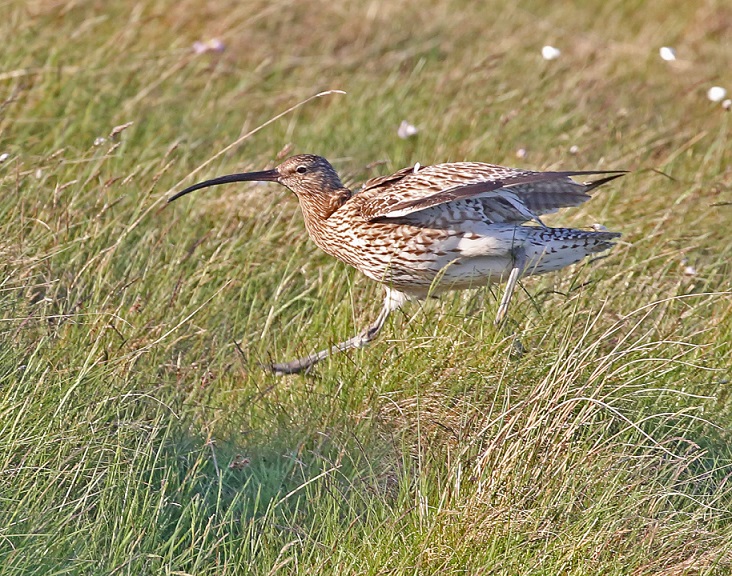 A more flamboyant version of distraction behavoir by a female curlew
A more flamboyant version of distraction behavoir by a female curlew
Picture courtesy of Kelvin Smith
Division of labour by curlew parents
In our latest update, Clive White shares his thoughts on the division of labour between the sexes.
The division of labour is governed by the conservation of energy. Females tend to produce four large eggs.
This must consume a substantial amount of energy and probably explains why female curlews are larger than males. As a result, females must expend more energy to take off. With less of a need to conserve energy,
defence of territory, eggs, and chicks, which often involves taking flight, falls to the males.
When establishing a territory, a curlew pair are seen together on their chosen area of land. But while the male is busy chasing off the males of neighbouring pairs, the female will often be feeding or standing on the ground.
After mating when the eggs are about to be laid, the male will be seen chasing off crows and other potential avian predators. Then during the 30-day incubation the male will remain very visible chasing off predators, but the female will be seen much less often. This difference in daytime behaviour suggests that the females carry out most of the incubation, with the males taking over mainly so females can go and feed.
These shift changes at the nest are infrequent but are what we look for to indicate nest locations.
Once chicks have hatched, both sexes will be on high alert. As before, the male will chase off avian predators.
But when the chicks are just hatched, and especially vulnerable, his efforts appear seemingly indiscriminate and directed at many species not previously considered a risk. When struggling to deal with a family of crows, buzzards, kites or mammalian predators (including humans), which are beyond his capability, his frantic alarm calls will draw in the female and neighbouring pairs to help drive away the danger.
Although, the female may decide its safer for the chicks if she stays with them, on the ground and alarm calls from there.
After a number of days, the parents’ anxiety levels appear to decrease, and they become less easily alarmed.
As their chicks grow, the parents may decide that the risk has diminished to the point where they remain undisturbed by overflying avian predators.
But mammalian predators will continue to induce high alarm in proportion to their proximity.
In the absence of any threats to their chicks, parents will remain silent, watching from a wall or spending time on the ground near the chicks. Why waste energy?
8th June 2022
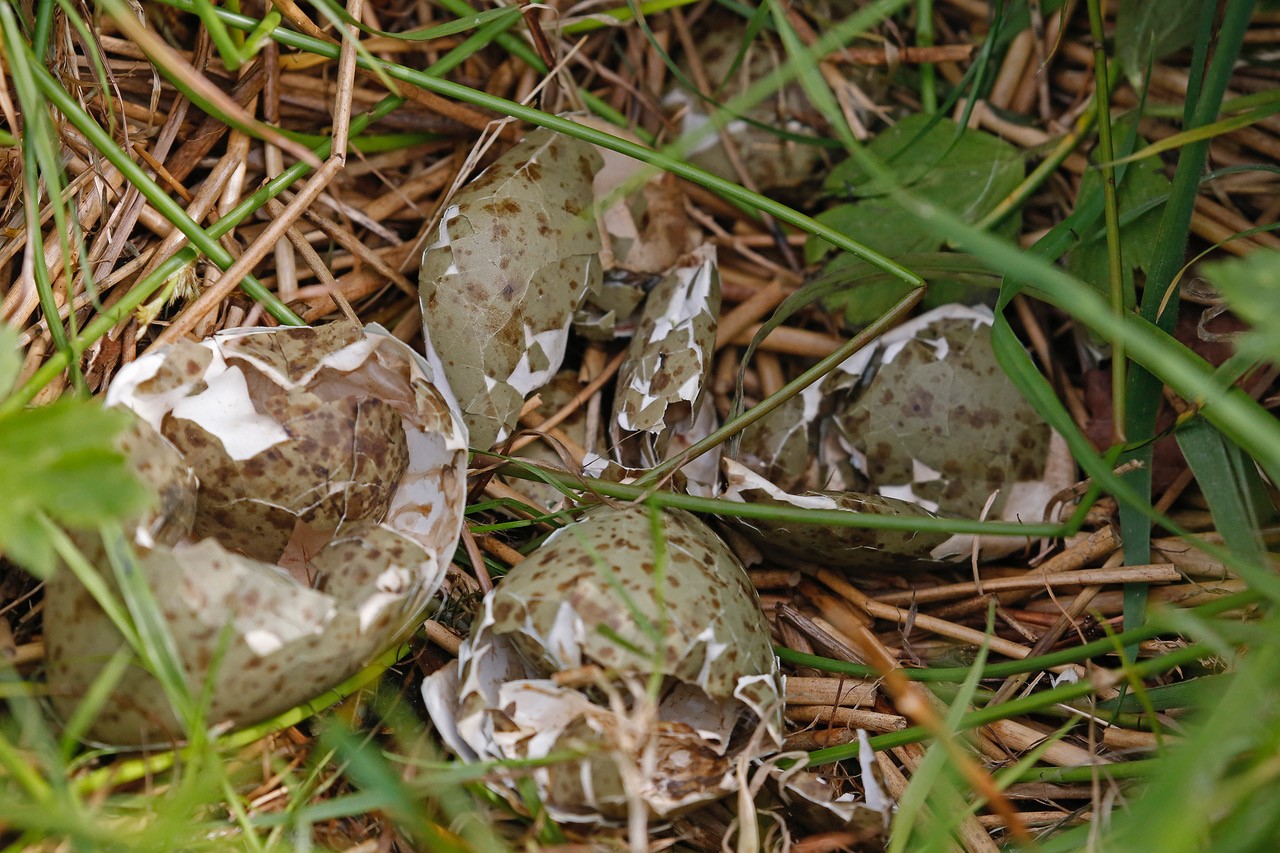 A hatched nest
A hatched nest
Picture courtesy of Kelvin Smith
Picture courtesy of Kelvin Smith
Guarding chicks
One of our curlew nests has had its eggs taken. But all the others have hatched at least one chick!
This photo shows one of our nests that successfully hatched all four eggs. The eggshells remain largely intact stuck to the membrane inside the egg and, characteristically, the irregular edges from the chick’s breakout are folded in.
If eggs have been predated the nest is either empty or contains only fragments of eggshell.
Curlew eggs are large eggs and difficult to carry off. So, if a nest is completely empty, a fox is usually the culprit.
Once the chicks have hatched, they bring more anxiety for the surveyors. Here Clive White shares his experience:
‘On 31st May a pair that I was watching, whose two chicks had hatched the previous day, started a commotion. They were clearly very agitated with “killywilly” alarm calls and had called in a neighbouring pair for reinforcement.
There was also a trio of magpies that had joined in the fray. I initially assumed it was the magpies upsetting the curlews,
but it became clear that the magpies were not the cause of the curlews’ concern when a fox jumped over a wall and ran across the field before disappearing into a wood.
I am pleased to report that the following day I saw one of the adults with one of the chicks strolling calmly through the grass.’
At first sight, chick guarding by curlews doesn’t seem consistent. At one extreme both parents appear constantly on guard.
Walking a few yards from their chick they are easily alarmed, frequently taking to the air to chase off crows and other potential predators.
At the other extreme, parents abandon this obsessive protective behaviour a few days after the chicks have hatched, becoming distinctly neglectful.
They cease to alarm call and stand idly by on walls or posts as buzzards and crows fly overhead, with the chicks no longer to be seen.
This behaviour produces more anxiety for the surveyors – have the chicks have been lost?
The keys to reconciling this, apparently conflicting, behaviour are conservation of energy and risk assessment.
Conservation of energy requires that energy is not expended unnecessarily. Risk assessment determines how much energy expenditure is required.
Hence, curlew parents whose chicks are in areas devoid of cover - grazed grassland or moorland - and at greater risk of predation, will be much more attentive than parents whose chicks are in the
long grass of a field shut up for silage making. Why waste energy chasing off crows and buzzards when your chicks are hidden from view, especially when that activity may itself alert predators to the fact that your chicks are in that field?
Much better to leave your chicks hidden in the long grass and go off to feed. The curlew pair in one of fields of long grass in our project area, has been observed leaving chicks unattended for more than an hour and a half while they fed in an adjacent field.
If the chicks have all been lost the parents will lose their territorial behaviour and disappear within 24 hours.
They will no longer stand guard on walls, and a field that was previously noisy with the calls of the parents will fall silent.
If the parents are still around at least one chick will still be alive!
Chicks hatching!
The first curlew chicks have been spotted in the project area!
Glimpsing a chick on Day Ash Farm was a real high for our surveyors after an emotional roller coaster of a week.
For several days they had been worried that they had not seen the
birds on the nest. Had the grass grown and hidden the sitting birds? Or had the
nest been lost?
Then one day the surveyors noticed the curlews chasing off jackdaws and kestrels, making loud alarm calls. Had the chicks hatched?
From a good vantage point, they watched the birds for a long time. Finally they were rewarded when one of the surveyors spotted a chick
as it scrambled over a clump of grass. A very lucky sighting given the length of the grass, but the excitement and the elation of the surveyors did confirmed
that chicks were present!
The surveyors started to move a little closer to try and determine how many chicks
were there. But the parent birds became disturbed, flying round them with staccato alarm calls. So the
surveyors immediately backed off.
They also noticed that when on the ground the adult birds constantly made soft peeping calls. Were these contact calls to the chicks?
Or sharing their location with each other?
Other groups of surveyors concerned that their pairs have disappeared, hope they will soon also see
the dramatic changes in curlew behaviour that herald the hatching of chicks. We eagerly await the daily sight of curlews perched on walls and posts watching over their chicks and
the frequent sound of alarm calls as parent birds alert them to potential danger.
Thanks go to all our surveyors who are experiencing the emotional stress that accompanies every
curlew breeding season.
Clive White
Darley Beck curlews are nesting
Many of our curlews have finished egg laying and are now incubating! The curlew surveyors are busy identifying nest sites – and this is a huge challenge.
It’s hard to see the birds when they are incubating. One parent will be hidden sitting on the nest and the other super secretive when close by. The only real chance to spot the birds is when they swap their nest
sitting shifts every two to three hours. So, time and patience are certainly needed.
As the chicks begin to hatch in two to three weeks (toward the end May-early June), the birds should become visible and noisy again.
Good news – to date our surveyors hard work has found eight potential or confirmed nests! Sadly, four pairs seem to have lost their clutches, but three of these look to be trying again.
We already knew curlews find cattle difficult to tolerate. But our early observations are revealing that our curlews also struggle in fields with high numbers
of sheep and lambs – because of the presence of the stock, also the crows and rooks they attract. Gangs of curious and boisterous lambs charging around, while fun for us to watch, are a particular problem for the curlew.
To better understand this, surveyors will be recording the approximate numbers of sheep and lambs in the fields during their surveys.
This will give us valuable information to help us give advice on stocking rates in the future.
There are around 18-20 curlew territories in our project area. This means there are still ten unidentified nests for surveyors’ visits and detective work still to find.
We know the surveys and nest detection takes frequent visits, a lot of time and hard work. The efforts of our wonderful volunteers are hugely appreciated. The surveys are already revealing so much valuable information we can use in the future. And the more information we have the more we can do to help our Darley Beck curlews.
A big thank you to all of our surveyors for all their hard work.
The curlew breeding season is hotting up!
The Darley Beck pairs of curlews are now more or less settled on their territories.
The males are becoming increasingly territorial and chasing away neighbouring males - presumably to stop them mating with their females.
So, in fields where recently you saw a pair of birds you might now only see one curlew. Don’t despair – this is probably the female,
conserving her energy to make eggs and holding the territory while the male careers around!
If mating is successful the first egg will be laid after 7-10 days, around the last week of April.
By the first week of May the clutch of 3-4 eggs should be complete and incubation will start.
Incubation takes four weeks and during this period the curlews tend to go quiet and are difficult to see. This is when the Darley Beck Curlew Surveyors will be working hard to try to locate and then protect the nests.
To avoid disturbance to the birds’ surveyors won’t be entering the fields but will be watching remotely.
It can be quite a challenge to locate the nests – Curlew Country advise that the best time is likely to be when the birds swap over their incubation shifts.
So, if you see volunteers sitting in their car watching fields for a couple of hours with a flask of tea or coffee, this is probably what they are doing!
And although this is quite intense work the curlews will already have given them some clues on where to look.
Generally, the curlews will nest in the fields where they have spent the most time while establishing their territories. They tend to choose the largest fields in their territories, away from walls, trees and other places from which predators can spot them.
And once the females start laying the males will vigorously drive the crows out of their nesting fields.
This will be a busy time for both the curlews and the curlew surveyors. But hopefully all the effort the surveyors have already put in to find the birds’ territories will make this nest detective work a bit easier!
The Darley Beck Curlew project thanks all its volunteer surveyors for all the time and effort they have already given and will spend on behalf of the curlews.
Curlew Conservation Project Given Green Light
Clip taken from Nidderdale AONB press release....
A new curlew conservation project, driven by a Nidderdale landowner, has received a grant from the new Farming
in Protected Landscapes programme.
The Darley Beck Curlew Project will look at reducing the risks of curlew egg and chick losses to silage
production and predators.
Curlews are in decline across the UK. In 2008, the curlew was deemed of global conservation concern and
listed as ‘Near Threatened’ on the Red List of Threatened Species.
Matthew Trevelyan, Farming in Protected Landscapes Officer (FiPL) at Nidderdale AONB, said: “Nationally,
the UK’s nature is under threat, with 41% of species in decline. A local landowner, Clive White, came to us
concerned the breeding success of curlews was limited in the Darley Beck Catchment by early grass cutting and
predation. Landowners and farmers are on the frontline as custodians of the land juggling commercial pressures.
Clive has done amazing work fostering partnerships and the permissions to survey land from other farmers.”
The farmers who have signed up for the first year have committed to permit bird surveyors to go on their
land to perform a detailed survey of breeding curlews. This survey will provide baseline data on the current
breeding success of curlews in the area. It will also provide information on the relative effects of predation
and farming activities, such as livestock grazing and silage harvesting.
Clive White, who has produced suckler beef for 35 years, said: “Producing livestock has given me access to
EU environmental grants, which has helped me to pursue my interest in nature conservation. It has also taught me
how hard it is to make a living stock farming especially given the size of farms in this area: every bit of land
has to be fully utilised to give a decent return.
Work will see ten farmers collaborating across a 400-hectare landscape. They will be
supported by two ecologists, Chris Tomson and Jackie Smith, who will train volunteers to monitor
the curlews, identify nest sites, and record habitat and field management.
Clive added: “It helps that we have Jason Drewery, a tenant farmer and Matt Trevelyan, the
FiPL funding officer at the AONB who is also a farmer, on our team. Most of the farmers who have
joined this cluster, especially the older ones, have noticed the decline in curlew numbers over
the last three or four decades and are willing to find out how they might be able to help reverse
this decline.”
Matthew Trevelyan has worked for more than ten years on the North York Moors, managing a
family farm. He has also worked as a dry-stone waller in the Peak District.
Matthew said: “As a farmer, I know that if these projects are farmer led, it will be of
great advantage. My experience of this fund to date is that, with a little imagination and passion,
it can be used to support brilliant and realistic projects that partner farmers with ecologists and
conservation organisations.”
The three-year Defra-funded programme aims to support those who live and work in AONBs and
National Parks across the UK. Applications are managed by Matthew and a dedicated team at Nidderdale AONB.
Professor Russell Wynn, Director of the Curlew Recovery Partnership, said: “We are delighted that
Nidderdale AONB has approved this bid focussing on curlew conservation. The hope is this project will
kick-start a long-term approach and form a ‘farmer cluster’ supporting curlew conservation, with scope
even for habitat creation. We’ll be supporting future initiatives around this.”
The Darley Beck Curlew Project aims to be ready for the 2022 breeding season.
Clive added: “When the surveyors’ results have been collated and assessed we will consult with the
members of the cluster to find out what they are able to do to help the curlews, and what kind of financial
help they might need to make the required changes to their farming practices.”
